Drawings That Can Be Seen From Space
Pictures from space! Our image of the day
Space can be a wondrous place, and we've got the pictures to prove it! Take a look at our favorite pictures from space here, and if you're wondering what happened today in space history don't miss our On This Day in Space video show here!
Mars rover shows off its sand escape skills

Friday: December 3, 2021: The ExoMars rover tested its ability to escape from sand in a recent test at an Italian 'training center' where it practices for its upcoming mission.
The test model of the joint European/Russian rover, which will set out for its trip to the red planet next year, used its wheel-walking mode that was designed by engineers specifically to help the rover get unstuck in sandy terrain.
Several Martian rovers in the past struggled to free themselves from sand dunes, with their wheels digging them deeper just like a car stuck in mud or snow.
Teams developing the ExoMars Rosalind Franklin rover, which will search for traces of life underneath the surface of Mars, have therefore developed the wheel-walking locomotion mode, which uses individual wheels like legs. In the test, it took Rosalind Franklin two minutes to cross the 6.6 feet (2 meters) wide sand trap. -- Tereza Pultarova
Astronauts suiting up for spacewalk
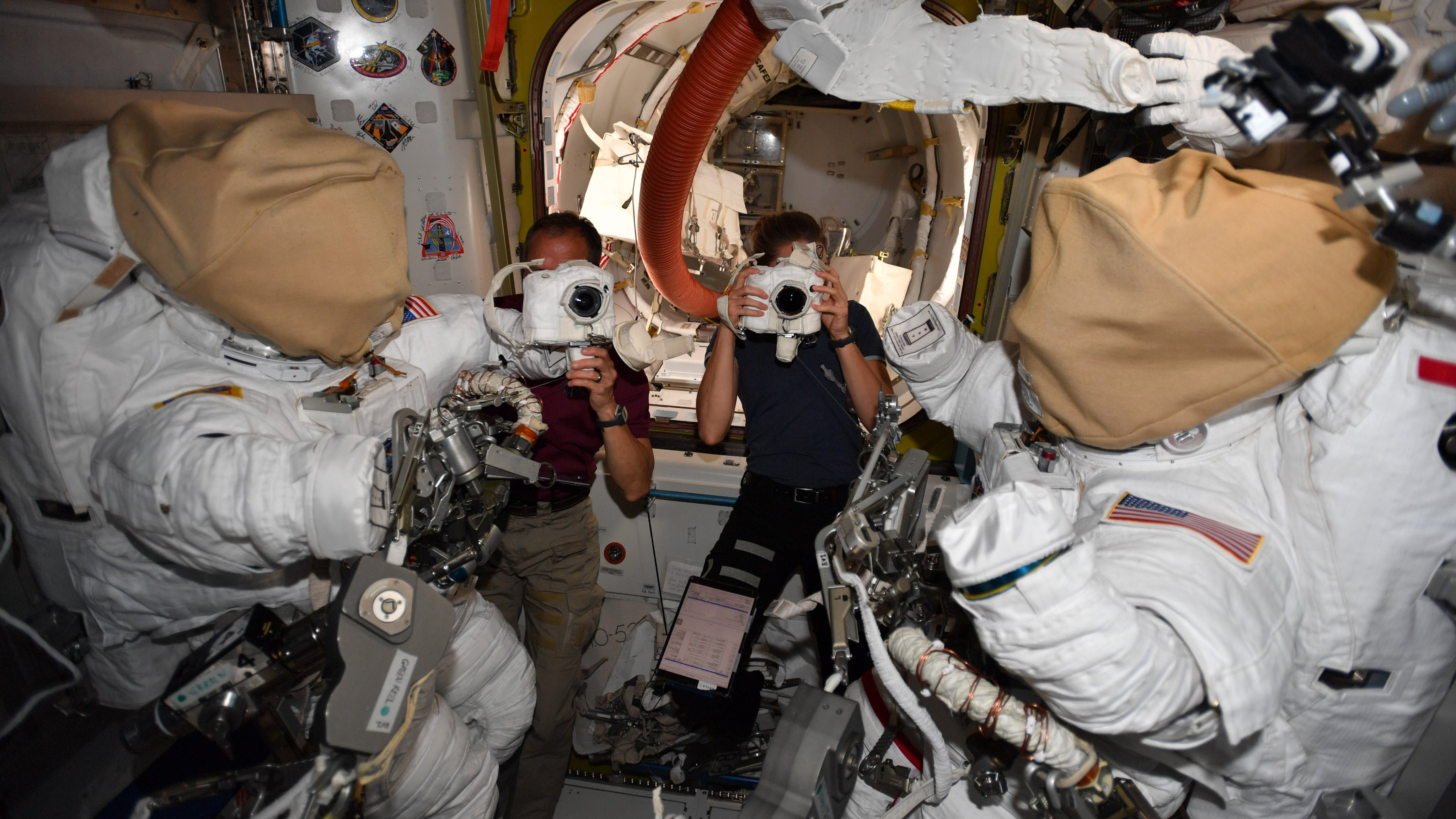
Thursday: December 2, 2021: NASA astronauts Kayla Barron and Thomas Marshburn are suiting up for a Thursday (Dec. 2) spacewalk in an image captured by their colleague Matthias Maurer.
During the more than six hour spacewalk, which was postponed because of space debris risk, the two astronauts replaced a faulty antenna on the space station's truss. For Barron, who is on her first space mission, this was also the first spacewalk. Mashburn, on the other hand, is a seasoned astronaut and an experienced spacewalker who has worked outside the space station multiple times since his first spaceflight in 2009.
The two spacewalkers arrived at the orbital outpost with SpaceX's Crew-3 mission on Nov. 11 together with Raja Chari, also of NASA, and European astronaut Matthias Maurer. It was Maurer who shared the image of the spacewalk preparations on his Twitter account. -- Tereza Pultarova
Pieces of an asteroid on a trans-Pacific trip

Wednesday: December 1, 2021: Precious extra-terrestrial samples delivered to Earth by a Japanese space probe last year crossed the Pacific Ocean, travelling incognito locked in unassuming black containers.
Scientists from the Japan Aerospace Exploration Agency (JAXA) accompanied pieces of asteroid Ryugu on their journey from Japan to NASA's Johnson Space Center in Houston, Texas.
Analyses of the asteroid bits will continue in laboratories in Japan and around the world, JAXA said in a statement.
Ryugu is a 0.6 mile-wide (1 kilometer) asteroid that scientists consider a potential threat to Earth. In 2018, Japanese spacecraft Hayabusa2 visited the asteroid, spending a year and a half studying its surface and structure. During its mission, the spacecraft collected three samples of material from the surface and near subsurface of the asteroid, which successfully arrived at Earth in December 2020. -- Tereza Pultarova
Satellites observe how La Palma volcano changes the island's shape

Tuesday: November 30, 2021: The volcanic eruption on the La Palma island continues spewing lava more than two months after it started, causing changes to the island's coast that are visible from space.
In this video, which consists of images captured by the European Sentinel 1 satellite between Sept. 14 and Nov. 27, the flows of lava spilling from the Cumbre Vieja volcano can be seen spilling into the ocean at popular tourist beaches, creating new peninsulas.
According to the latest news report, new lava rivers burst out of the fiery crater over the weekend, threatening further destruction. Since the beginning of the eruption, the lava streams have already buried nearly 2,800 buildings and 1,148 hectares of land. -- Tereza Pultarova
Mesmerizing nebula around dying star revealed in new Hubble image

Monday: November 29, 2021: The Hubble Space Telescope captured a new image of a nebula with a fast-expanding halo surrounding a dying star.
The nebula, called NGC 689, is part of the constellation Dolphin, which is located close to the celestial equator in the northern hemisphere.
Astronomers estimate that the outer shell of the halo surrounding the nebula is about 28,000 years old, while the inner shell is only 4,800 years old. These different layers suggest the star at the center of this nebula died in several violent outbursts before collapsing into the dim white dwarf it is today.
The image also reveals the finer structure of the nebula including filaments and knots surrounding the star. -- Tereza Pultarova
Space Station Thanksgiving dinner looks like camping lunch

Friday: November 26, 2021: Astronauts at the International Space Station enjoyed a Thanksgiving dinner that may have seemed a bit underwhelming, at least based on images shared by European astronaut Matthias Mauer on Twitter.
In the pictures, members of the current space station crew can be seen tucking into all sorts of canned lunch meats and packaged foods. The dishes float around in a rather messy way, including ketchup and mayonnaise, and fresh fruits such as apples and oranges.
While mainly an American celebration, at the space station, astronauts of other nationalities joined in including Russian cosmonauts Pyotr Dubrov and Anton Shkaplerov.
"One of the best things about international collaboration? Sharing international celebrations and culture," Mauer said in the tweet. "I'm thankful for all my crewmates up here on the Space Station and everyone supporting our mission from Earth." -- Tereza Pultarova
Milky Way and its dwarf neighbors have only just met, study suggests
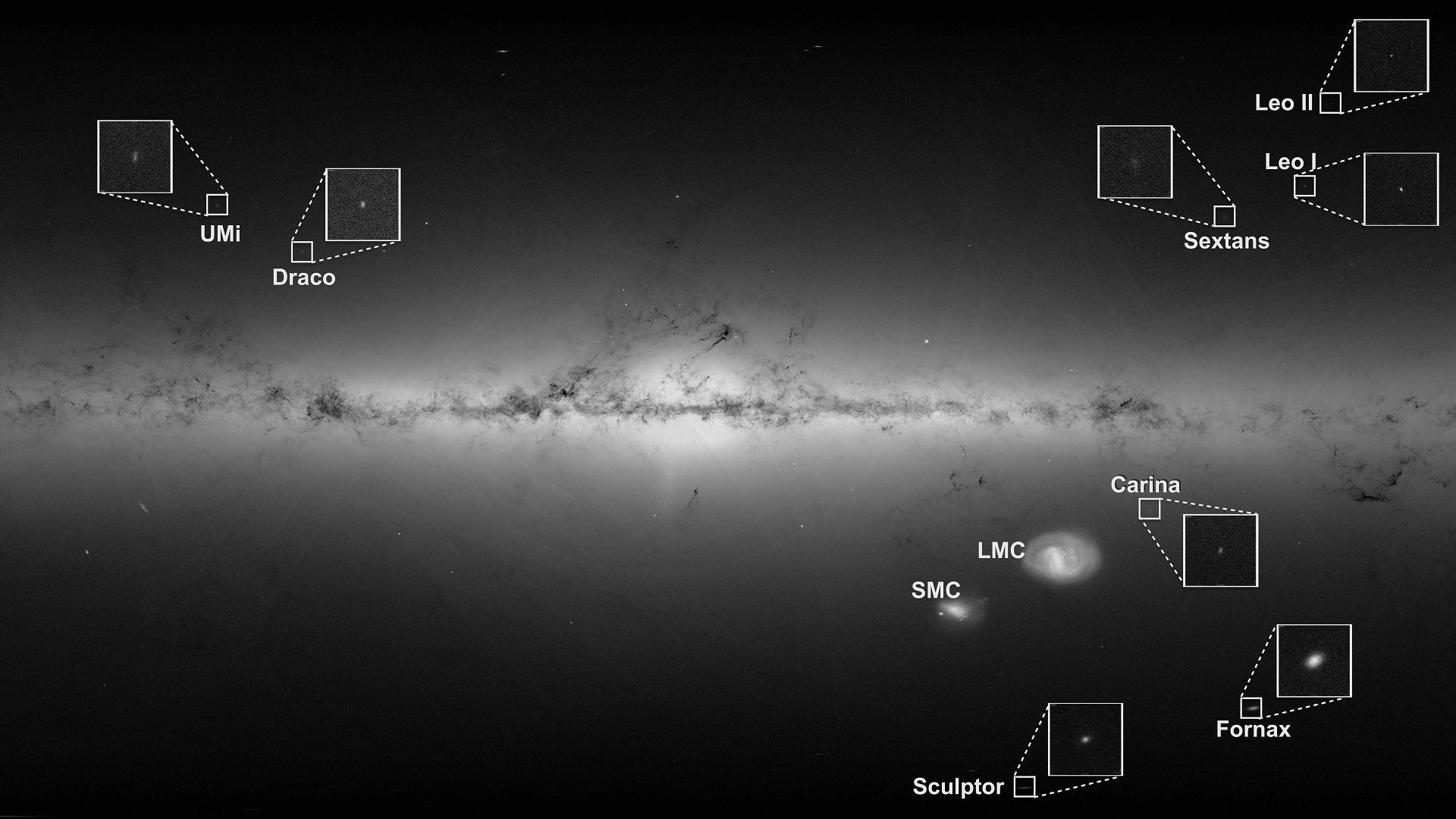
Thursday: November 25, 2021: Our galaxy, the Milky Way, can be seen in this image surrounded by a group of dwarf galaxies that according to a new study are passing by for the first time.
Previously, astronomers believed these galaxies, about 50, have been orbiting the much larger Milky Way for billions of years. A new analysis of data from the European Space Agency's Gaia mission now revealed that the majority of those dwarf galaxies are newcomers in the Milky Way's neighborhood. Scientists will now have to rethink the evolution of the Milky Way, ESA said in a statement, as well as the chemical composition and nature of these small galaxies. -- Tereza Pultarova
DART's asteroid-deflecting mission begins
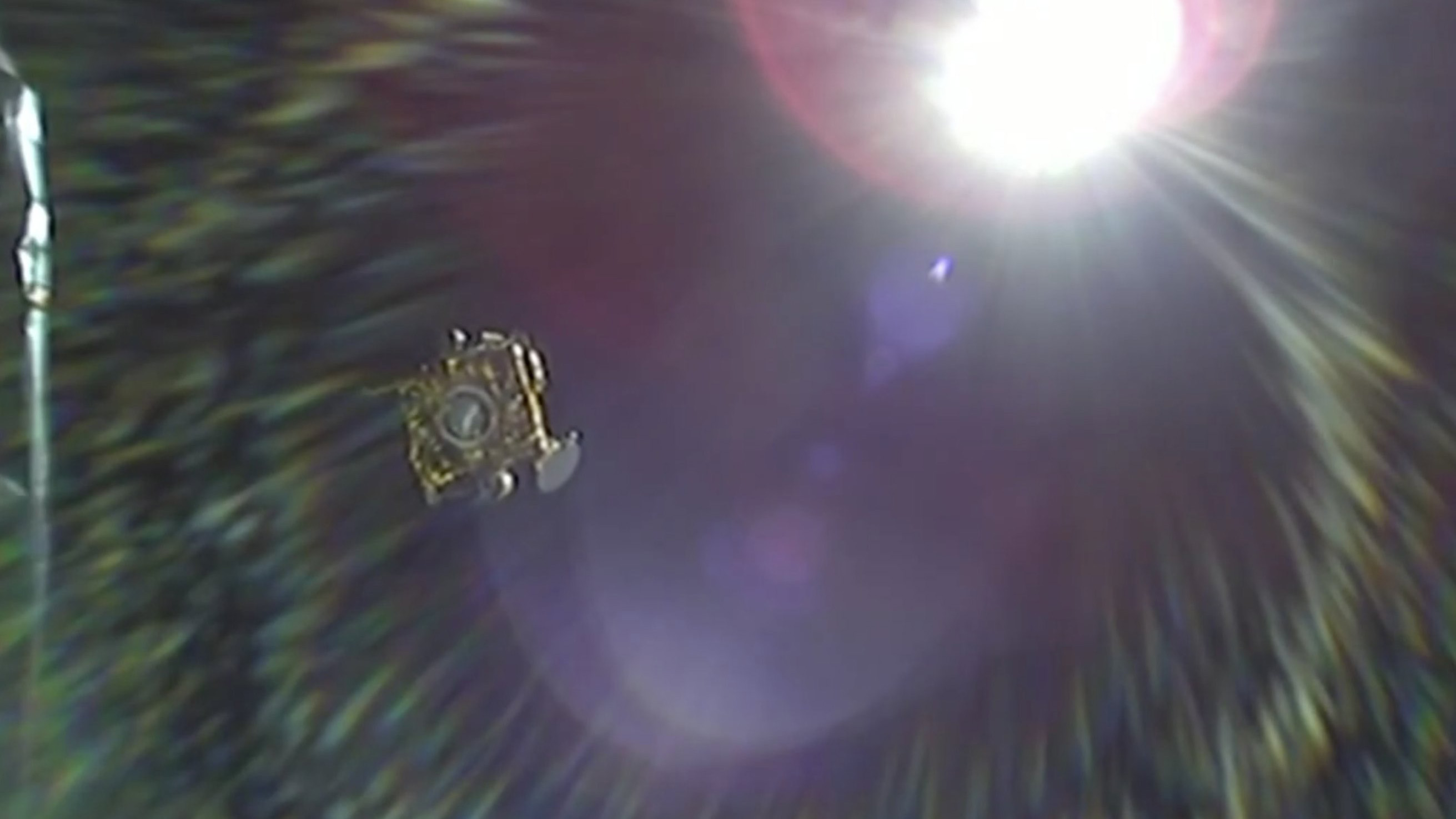
Wednesday: November 24, 2021: The asteroid-smasher DART can be seen in this image separating from SpaceX's Falcon 9 rocket which launched it on its one-year journey towards its target asteroid Didymos on Tuesday (Nov. 23).
DART, or Double Asteroid Redirection Test, will smash into a small asteroid called Dimorphos which orbits the larger space rock Didymos next year. The goal of this self-destructive encounter is to change the orbit of Dimorphos around Didymos. The experiment is designed to prove that such an operation can possibly protect Earth from a collision with a space rock. -- Tereza Pultarova
Asteroid deflector ready to go
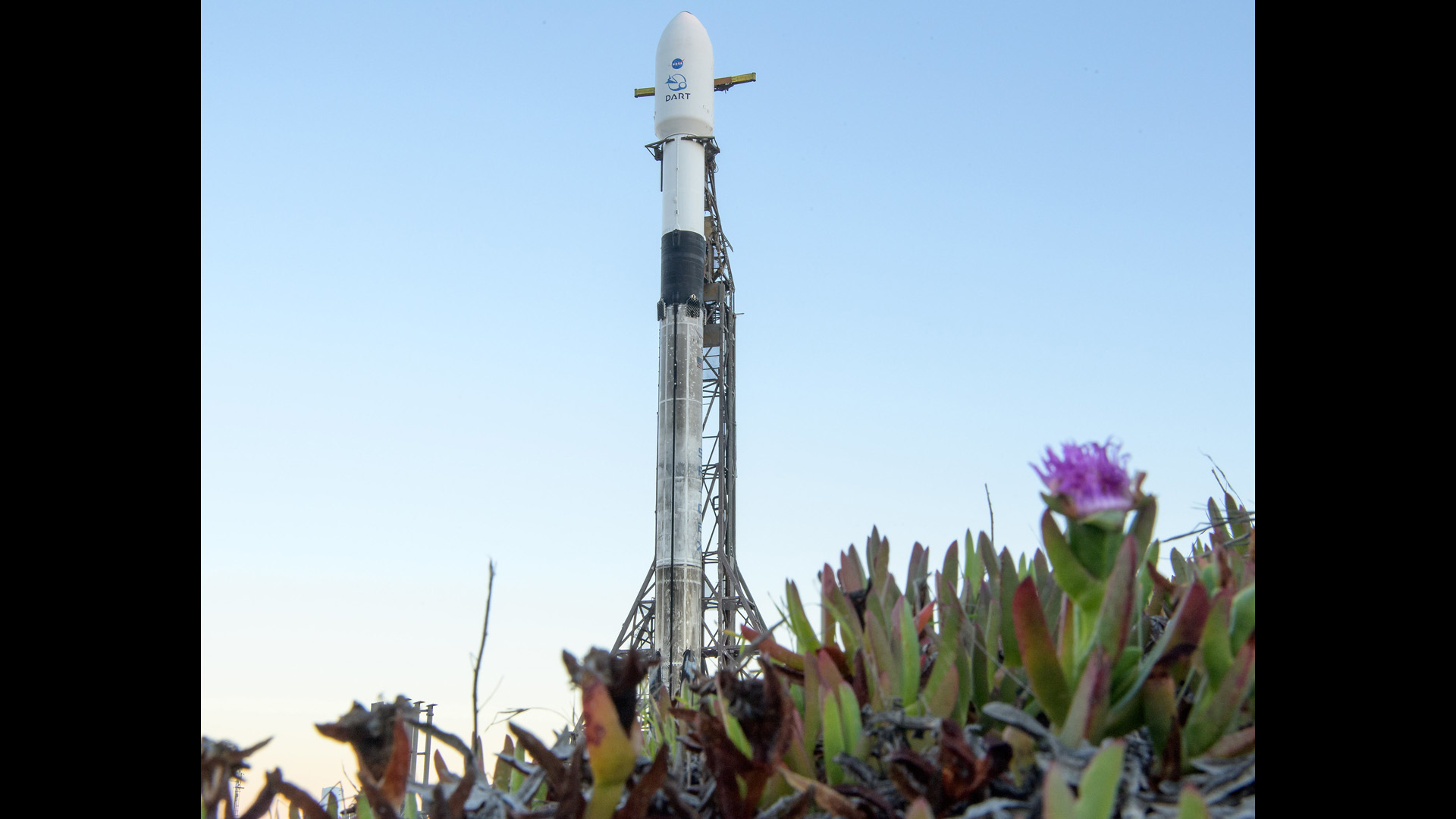
Tuesday: November 23, 2021: NASA's Double Asteroid Redirection Test spacecraft (DART) is sitting atop SpaceX Falcon 9 rocket at Vandenberg Space Force Base, ready to commence its ground-breaking asteroid-deflection mission.
DART will take one year to reach a binary asteroid called Didymos and its moon Dimorphos, which is the ultimate target of DART's self-destruction mission. DART will ram into Dimorphos at full speed in an attempt to change its orbit around Didymos. The experiment will verify whether humankind can potentially deflect an asteroid on a collision course with Earth. -- Tereza Pultarova
Star-forming nebula glows in Hubble Space Telescope image
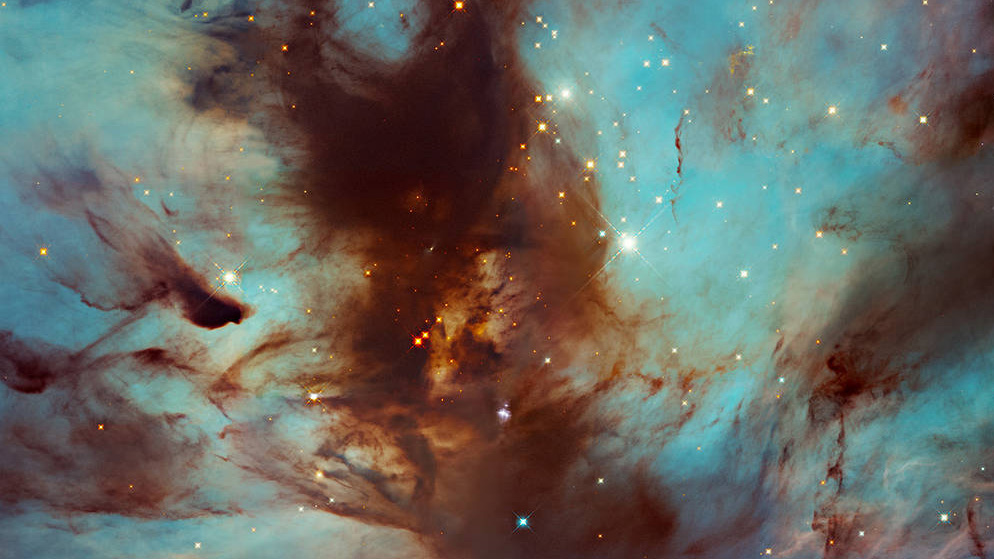
Monday: November 22, 2021: The Hubble Space Telescope captured this image of the Flame Nebula some 1,400 light years away from Earth during its search for brown dwarfs, mysterious objects scattered through the universe that are too dim to be called stars but too bright to be called planets.
The Flame Nebula is part of the Orion Molecular Cloud Complex, a known star-forming region in the constellation Orion. Scientists know that hidden in the cloud of thick dust at the heart of this nebula is a star cluster. The nebula absorbs radiation from the triple star Alnitak, the easternmost star in Orion's belt. This radiation ionizes hydrogen gas in the nebula, which then gradually cools, emitting visible light, which can be seen as the glow in this image. -- Tereza Pultarova
Last lunar eclipse of 2021 wows stargazers in America
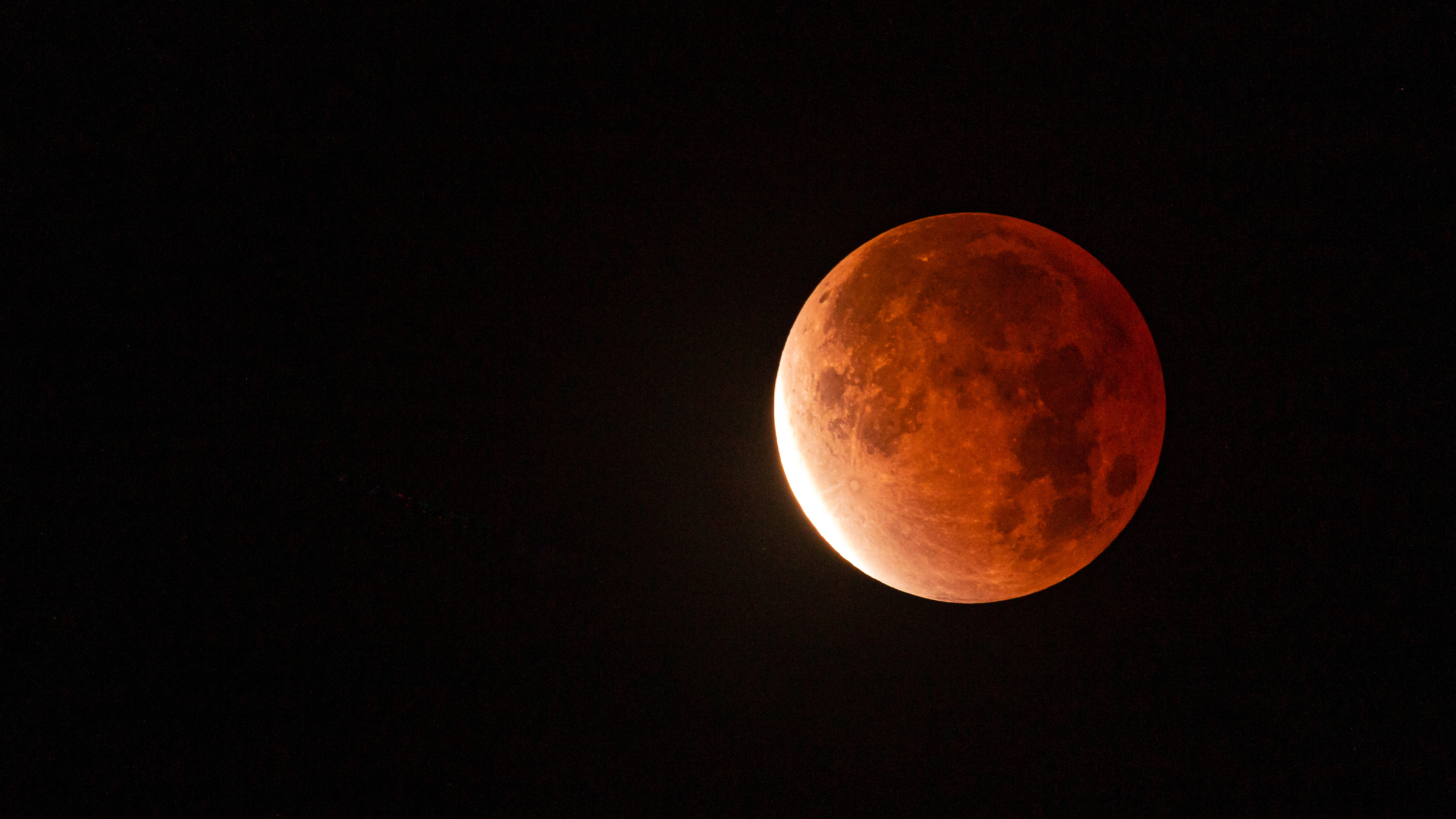
Friday: November 19, 2021: The last lunar eclipse of 2021 and the longest in 600 years has turned the full moon red for observers in North America and other parts of the world today.
This image was captured by astrophotographer Tyler S Leavitt, who observed the celestial spectacle near Las Vegas, Nevada.
"Dodging clouds and haze, caught a few seconds of clear sky," Leavitt said in an email.
The eclipse saw the moon 97% covered by the shadow of Earth, enough to create the reddening effect which is caused by the refraction of light in Earth's atmosphere.
The eclipse lasted a little over 6 hours. The moon first entered the penumbra, the imperfect shadow at the beginning of the alignment between Earth, moon and the sun at 1:02 am EST (6:02 GMT). The spectacle peaked with nearly all of the moon in the planet's deep shadow three hours later. The moon exited Earth's deep shadow shortly before 6 am EST (11 am GMT) and a little over an hour later, the longest partial lunar eclipse in nearly 600 years was over.
Next, the world will enjoy a total lunar eclipse, which will take place in May 2022. It will be best observed from South America and the eastern parts of North America. -- Tereza Pultarova
Hubble spots a new star's birth
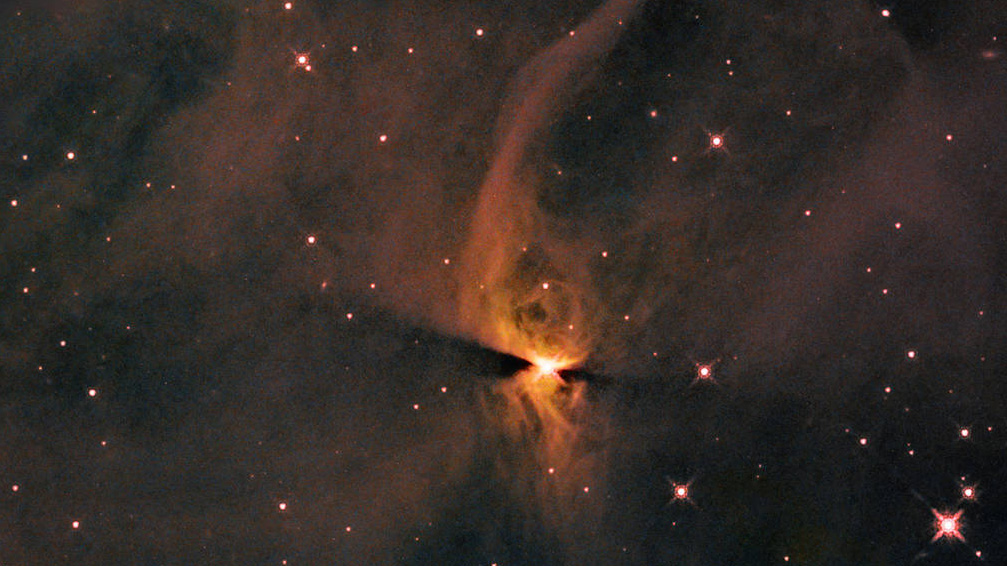
Thursday: November 18, 2021: A new star just being born inside a distant cloud of collapsed dust and gas can be seen in this image captured by the Hubble Space Telescope.
The protostar, with a not easy to remember name J1672835.29-763111.64, was spotted in one of the closest active star forming regions to our planet, the Chameleon cloud. This cloud, located in the constellation Chameleon, is visible in the sky from the southern hemisphere.
The protostar is part of a nebula called IC 2631, which reflects light from nearby stars.
The protostar emits light as dust and gas accumulates in the surrounding dust cloud. At a certain moment, the density and temperature of the accumulating material will be sufficient to trigger nuclear fusion, the reaction that sustains the life of stars. The leftover gas and dust can then give rise to planets, asteroids, comets, or remain as dust.
Hubble captured the image as part of a survey targeting 321 protostars previously found by the Spitzer and Herschel infrared telescopes. -- Tereza Pultarova
Satellites watch Canadian town hit by 2021 wildfires swamped by floods

Wednesday: November 17, 2021: A Canadian town that spent weeks on evacuation alert due to this year's summer wildfires has been swamped by floodwater after two days of torrential rain.
The extent of the flooding can be seen in this animation, consisting of before and after images of the area near Merritt, British Columbia, taken by the European Sentinel 1 satellite.
All 7,000 residents of the town, some 125 miles (200 kilometers) northeast from Vancouver, have been evacuated after floodwater from the swelling Coldwater River completely overwhelmed the local wastewater treatment plant. The floods triggered mudslides in some areas, which killed at least one person. -- Tereza Pultarova
Ariane 5 readied for James Webb Space Telescope launch

Tuesday: November 16, 2021: The Ariane 5 rocket that will lift the James Webb Space Telescope, the most powerful space telescope ever built, into orbit next month, is being readied at the European Spaceport in Kourou, French Guiana.
The rocket was raised into a vertical position in the past few days at the spaceport's launch vehicle integration building, awaiting the arrival of the solid rocket boosters that will help it off the ground with its precious 6.8-ton (6.2-tonne) payload.
The launch of the James Webb Space Telescope is scheduled for Dec. 18. After its release from the Ariane 5 fairing, the space observatory will require a month to reach its destination in the sun-Earth Lagrange point 2 (L2) some 940,000 miles (1.5 million kilometers) from Earth. At L2, the gravity of our planet and the sun are in balance, which means the spacecraft will retain a relatively stable position as it looks into the most distant universe. -- Tereza Pultarova
Antarctica's fastest melting glacier dwindles in front of satellite's eyes

Monday: November 15, 2021: The Pine Island Glacier in West Antarctica is captured melting away in this time-lapse video comprising satellite images captured between 2015 and 2021.
The Pine Island Glacier is Antarctica's fastest melting ice sheet and according to researchers has retreated by 11 miles (18 kilometers) over the past 6 years. The Pine Island Glacier alone is responsible for 25% of Antarctica's ice loss, thinning, receding and flowing into the Amundsen Sea at an accelerating pace.
Because the glacier is far away from all existing Antarctic research bases (the nearest one is over 800 miles (1,300 kilometers) away), satellites provide the most convenient way to study its evolution. A recent study found that the glacier's melting has sped up in the past few years due to the melting of a floating ice shelf that helps keep it in place. -- Tereza Pultarova
Satellite images reveal how cities eat up land

Friday: November 12, 2021: Images collected by the US Landsat satellites since 1985 reveal how cities all over the world speedily devour surrounding land.
In this animated image, the Thai capital Bangkok, can be seen spreading farther and farther away from the Chao Phraya River delta on the shores of the Gulf of Thailand.
The images were collected as part of the World Settlement Footprint project, spearheaded by the Google Earth Engine. The visualizations, showing the scale of global urbanization, were revealed during the United Nations Climate Change Conference (COP26) in Glasgow, which is concluding this week.
According to the European Space Agency (ESA), which is part of the project, 55% of the global population currently resides in large cities. The number is expected to rise to 68% by 2050. Rapid urbanization combined with the progressing climate change can lead to problems with air pollution, vulnerability to weather-related disasters and problems with supplies of water, energy and raw materials, the agency said in a statement. -- Tereza Pultarova
A merger of distant galaxies observed by South African radio telescope
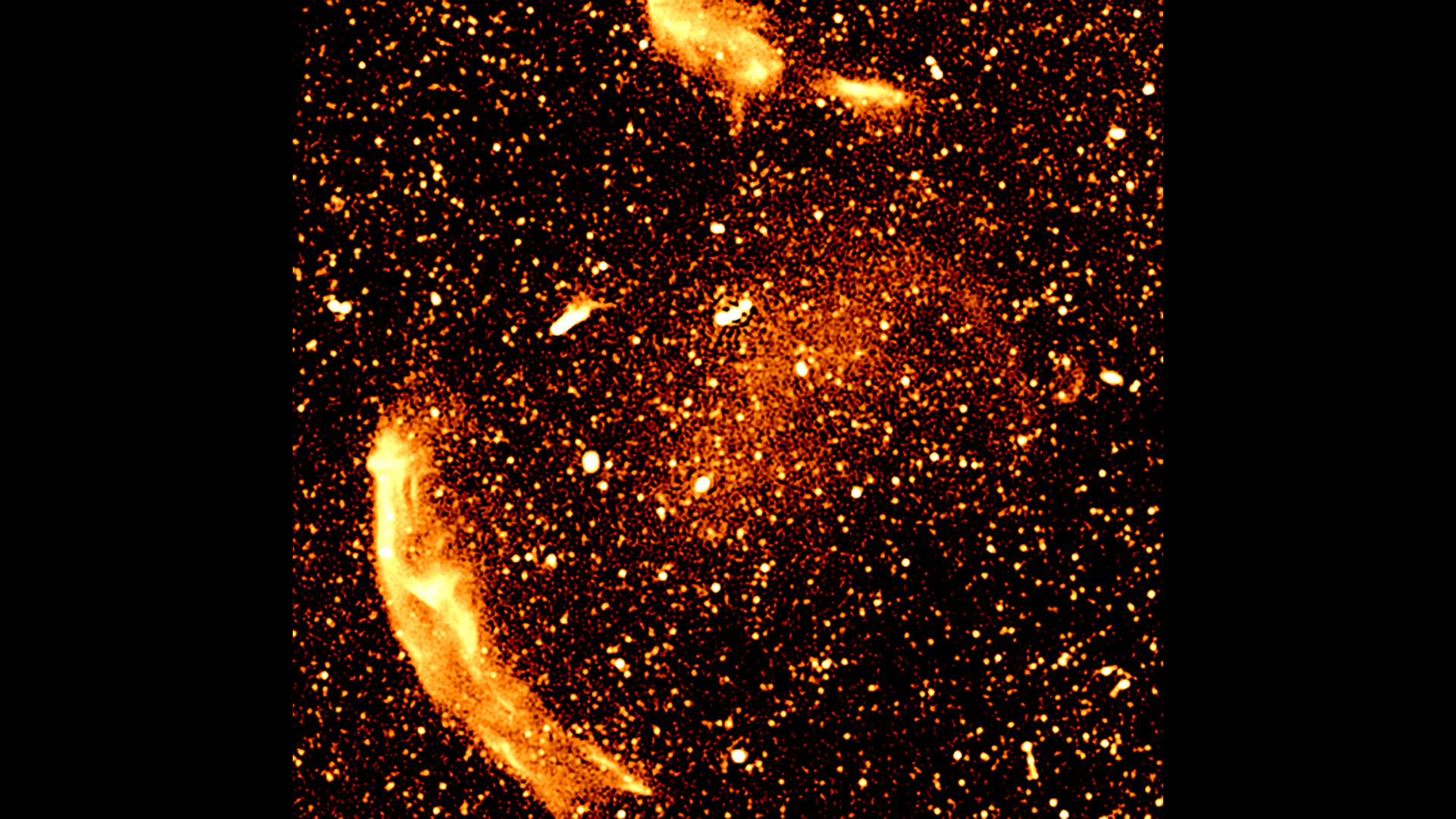
Thursday: November 11, 2021: A collision of two distant galaxy clusters taking place millions of light years away from Earth has been captured by the South African MeerKAT radio telescope.
The image spans approximately 10 million light-years and is sprinkled with point-like radio emission from even more distant Milky Way-like galaxies.
The radio image also reveals clouds of gas in the intergalactic space, stirred up as the clusters spin around each other pulled ever closer by their enormous gravitational forces.
The image was obtained as part of a large-scale imaging campaign that surveyed radio emissions from 115 clusters of galaxies. The observations, comprising over 1,000 hours of telescope time, were conducted in the year after MeerKAT's 2018 inauguration.
It took two years and a team of over 40 researchers to convert the raw data into the stunning images that have been presented today in the journal Astronomy & Astrophysics. -- Tereza Pultarova
Crew Dragon departs against coral atoll backdrop
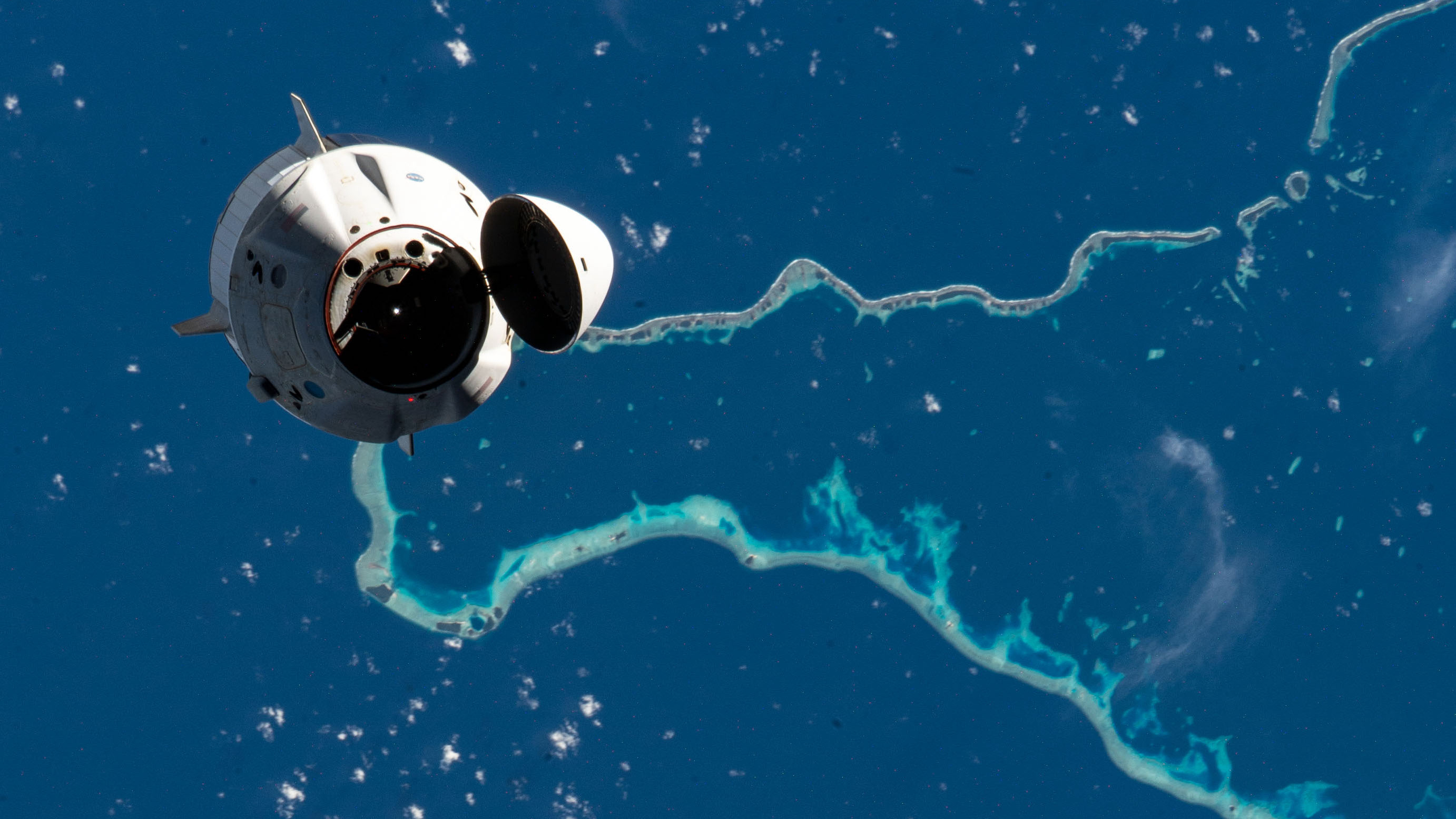
Wednesday: November 10, 2021: The Crew Dragon capsule Endeavour can be seen in this image against a range of Pacific coral islands shortly after its departure from the International Space Station on Monday (Nov.8).
The picture, taken from aboard the orbital outpost, captures the Dragon capsule during a fly-around maneuver, which it performed shortly after detaching from the station's Harmony module. The capsule completed a circle around the station at a distance of 660 feet (200 meters) to allow astronauts to photograph the orbiting laboratory before heading of to Earth.
This was the first complete fly-around performed by any spacecraft since the retirement of NASA's space shuttle in 2011. In October, Russian cosmonauts performed a partial fly-around with the Progress capsule during a relocation maneuver that freed a docking port for another capsule bringing a Russian film crew to the space station.
Inside the Dragon that departed on Monday were American astronauts Shane Kimbrough and Megan McArthur, European Thomas Pesquet and Japan's Akihiko Hoshide. The picture was taken as both, Dragon and the space station, flew 259 miles (417 kilometers) above the Jaluit Atoll in the Marshall Islands. The crew landed safely later that day off the coast of Florida. -- Tereza Pultarova
Thomas Pesquet getting used to gravity after six months in space

Tuesday: November 9, 2021: The European Space Agency (ESA) astronaut Thomas Pesquet after exiting the SpaceX Crew Dragon capsule after splashdown off the coast of Florida on Monday (Nov.8).
Pesquet is seen in this video supported by a medical team as his body adjusts to gravity after 199 days in weightlessness aboard the International Space Station. Astronauts experience widespread changes in their brain and body during spaceflight including bone and muscle loss, some of which take months to reverse.
Immediately after landing, astronauts tend to have problems with balance and movement coordination. According to NASA, these problems usually resolve after three days back on Earth. Pesquet will continue his recovery in Cologne, Germany, the home of ESA's Astronaut Centre (EAC) and German Aerospace Centre's (DLR) 'Envihab' research facility, which studies the effects of spaceflight on the human body. -- Tereza Pultarova
Space station crew enjoys most spectacular aurora thanks to cannibal eruption

Monday: November 8, 2021: Astronauts at the International Space Station enjoyed the most spectacular aurora display of their entire mission over the weekend after a massive blast of material from the sun reached our planet.
The sun has been acting out lately, waking up to its new period of activity after years of quietness. This variation is part of the sun's regular 11-year cycle, the little understood ebb and flow of sunspots and solar flares that is next set to peak in 2025.
The latest aurora feast, observable from locations much farther to the south than usual, also delivered a stunning spectacle for the current space station crew.
"We were treated to the strongest auroras of the entire mission, over North America and Canada," European Space Agency's astronaut Thomas Pesquet tweeted with a mesmerizing photo of greenish glow. "Amazing spikes higher than our orbit. Star-struck, and we flew right above the centre of the ring, rapid waves and pulses all over."
The latest aurora display was triggered by a double coronal mass ejection, two bursts of magnetized plasma that the sun blasted out last week within a short period of time. The second outburst, travelling a bit faster than the first one, cannibalized its predecessor on the way, resulting in a much more powerful plasma cloud than originally expected.
Auroras get triggered in Earth's atmosphere when magnetized plasma particles from the sun hit the Earth's magnetic field, creating a temporary magnetic havoc around the planet. -- Tereza Pultarova
Lunar mini-rovers take a test ride in fake moon dust
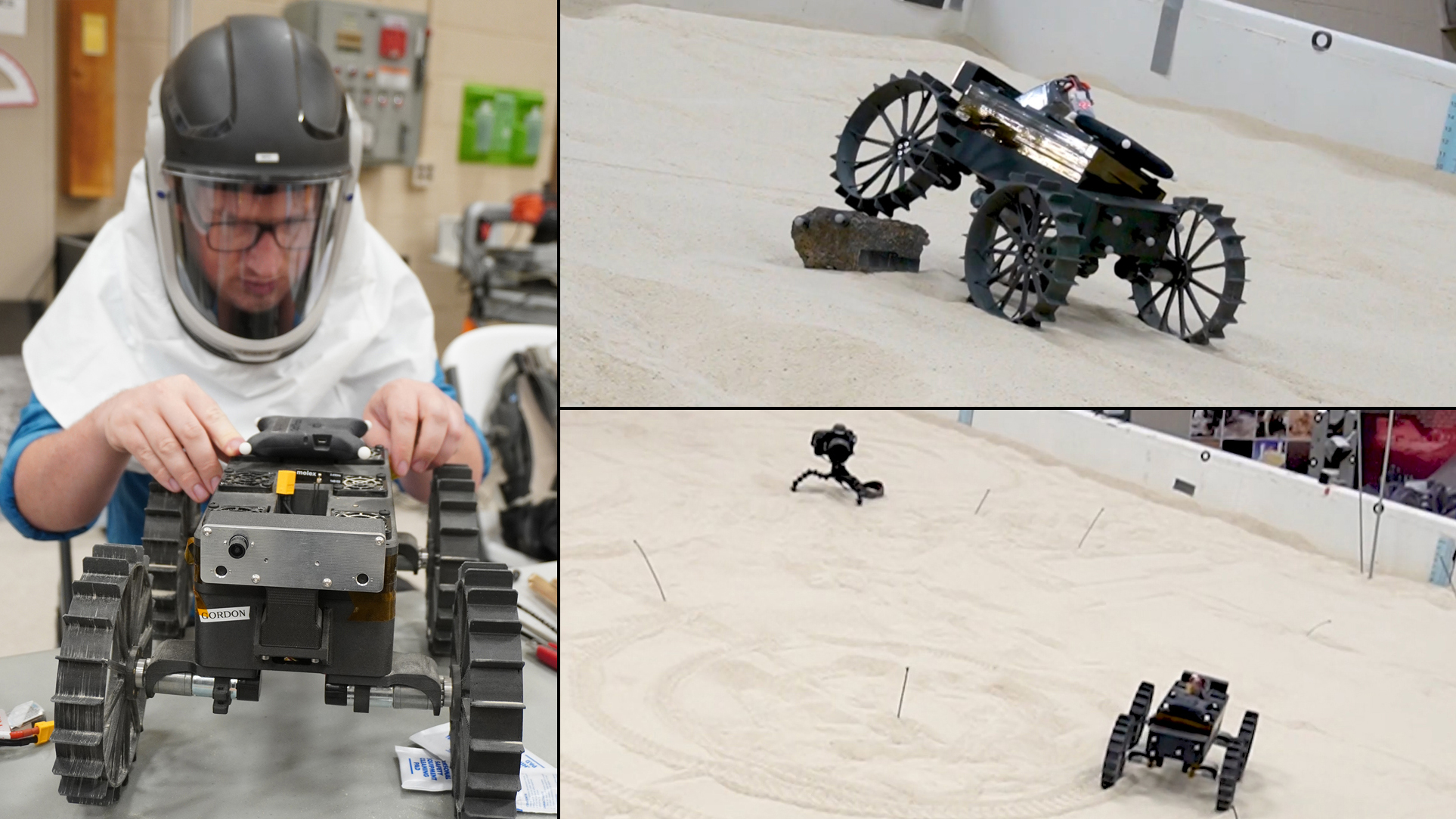
Friday, November 5, 2021: Miniature autonomous rovers designed to explore the surface of the moon as a team showed how they can handle lunar soil in a recent lab test.
The mini-rovers, part of NASA's project called Cooperative Autonomous Distributed Robotic Exploration (CADRE), are each about the size of a shoe-box. Deployed in large numbers, they can survey the moon in a way that a single large rover cannot achieve.
In a latest set of experiments at the Simulated Lunar Operations lab at the Glenn Research Center in Cleveland, NASA engineers tested how well the rovers' wheels deal with the fine-grained regolith as well as larger rocks that can be found on the surface of the moon.
The rovers might fly to the moon within the next five years as part of NASA's Commercial Lunar Payload Services Initiative. -- Tereza Pultarova
Dried out Turkish lake a portent of a climate change future
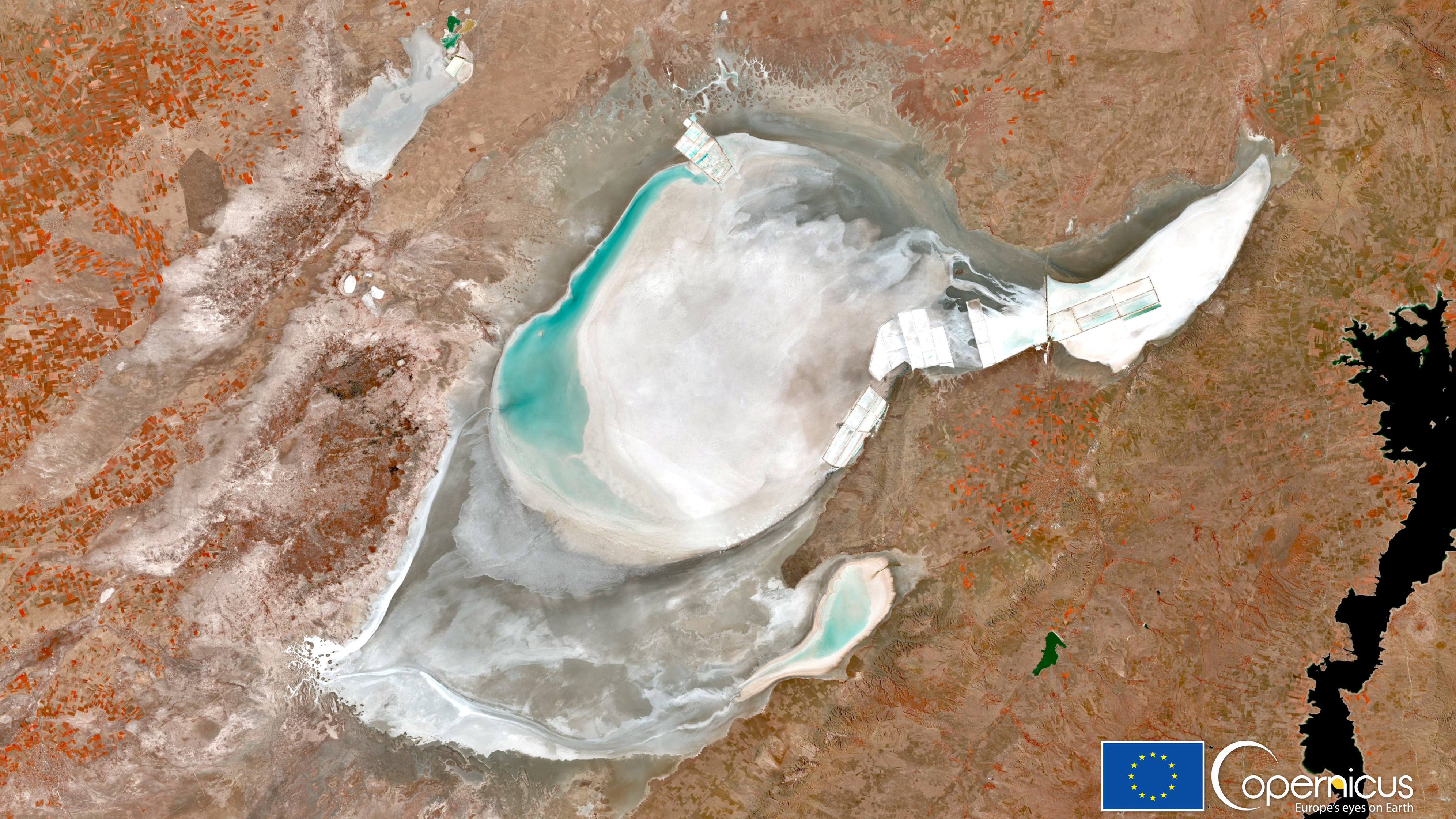
Thursday, November 4, 2021: Thousands of stunning flamingos perished this summer after Turkey's second largest lake completely dried out due to climate change-induced drought and excessive water use by farmers.
This image, taken by the European Union's Copernicus Sentinel 2 satellite on Oct. 23 shows Lake Tuz in central Turkey, under normal circumstances one of the world's largest salty lakes. But in this image, there is no water in the lake and what used to be its floor is covered in dried out deposits of salt.
Lake Tuz is a so-called hypersaline lake, a lake with salinity greater than that of the ocean. Such lakes have no outlet that would take incoming water away. They only lose water by evaporation which leads to the gradual salt build-up. The lake normally varies in size depending on the season. But over the past years it has been gradually shrinking.
The current state of the lake threatens populations of water birds, most significantly the greater flamingo, which has a major breeding colony on its shores. -- Tereza Pultarova
New flare from the sun promises another aurora display

Wednesday, November 3, 2021: The sun has fired another powerful burst of plasma towards Earth on Tuesday (Nov. 2), which, scientists say, may trigger another round of spectacular aurora displays.
This latest coronal mass ejection (CME), an eruption of ionised gas and magnetised particles from the sun's outer atmosphere, the corona, follows on a powerful flare from Oct. 28. That flare caused geomagnetic storms in Earth's atmosphere, observable as colorful auroras in northern Europe, Canada and the U.S.
The new coronal mass ejection came from a different sun spot than the one last week, NASA's Solar and Heliospheric Observatory (SOHO) mission said on Twitter. It was this observatory that captured the above video from its vantage point about 900,000 miles (1.5 million kilometers) from Earth.
"And yet another spectacular halo CME directed towards Earth," the SOHO mission said on Twitter. "This one was produced by [active region] AR 12981 near the central meridian and erupted just a few hours after another large CME from [active region] AR 12887. Let's hope that this one will produce more impressive aurorae than the Halloween storm." -- Tereza Pultarova
Extreme weather events are a new normal, such as this storm in Pacific Northwest

Tuesday, November 2, 2021: Extreme weather events are becoming a new normal amid the rapidly progressing climate change, according to the World Meteorological Organization. This time lapse shows one such event: a powerful extratropical storm that hit the Pacific Northwest on Oct. 24 and 25.
The storm, captured here in an animation based on data from the GOES-17 satellite operated by the National Oceanic and Atmospheric Administration, reached central atmospheric pressure equivalent to a category 4 hurricane. According to NASA, the storm was one of the most intense ever to strike the Pacific Northwest, drawing a historic amount of moisture into the region.
In fact, this storm was one of two extreme low pressure storms to hit the area within one week. Both of these storms channelled massive amounts of moisture from Hawaii in what meteorologists call atmospheric rivers.
In Marin County, 16.55 inches (42 centimeters) of rain fell within 48 hours. Downtown San Francisco reported a record-setting 4.02 inches (10 cm) on Oct 24 alone. In Blue Canyon, California, 10.4 inches (26 cm) fell within a 24-hour period.
The downpours triggered flash floods in many areas but also doused the wildfires that are still smoldering in places after this year's extreme fire season. -- Tereza Pultarova
Satellites observe unrelenting progress of climate change
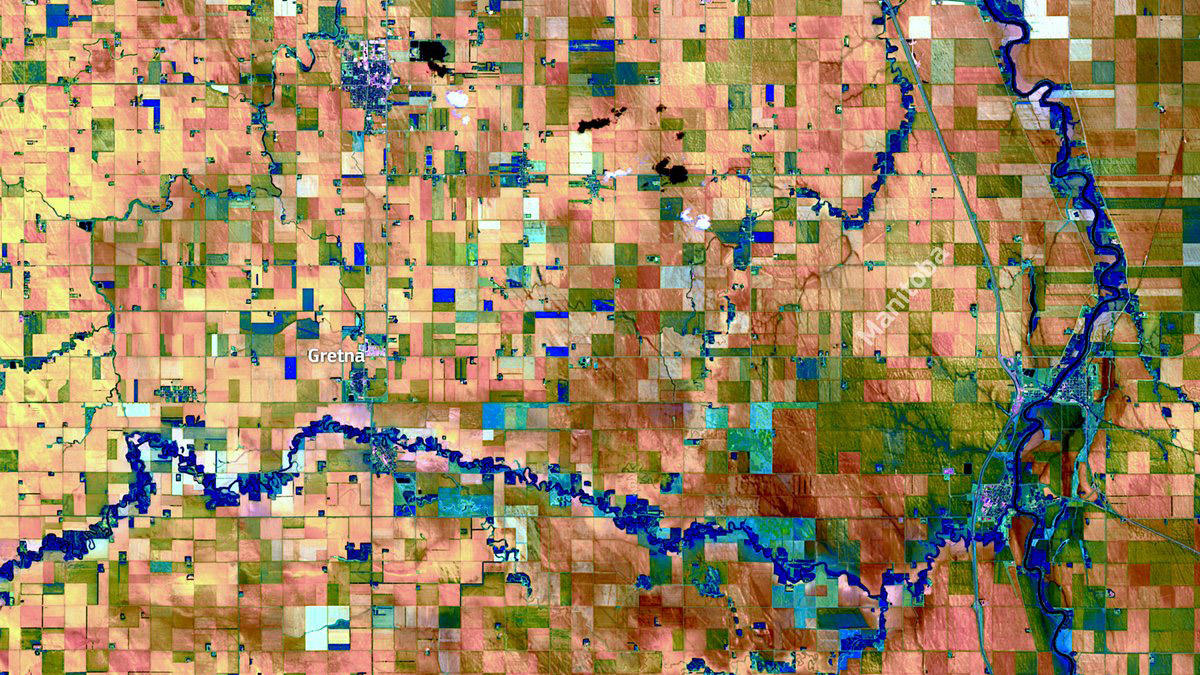
Monday, November 1, 2021: Satellites play a key role in monitoring the Earth's rapidly changing climate. This image, taken in June this year by a European satellite, shows what a record-breaking heatwave in a Canadian town looked like from space.
Today, the United Nations' 2021 Climate Change Conference, also known as COP26, kicked off in the Scottish city of Glasgow with the hope of thwarting the unrelenting progress of global warming, brought about by the previous reluctance of global leaders to take firm and speedy action to curb greenhouse gas emissions.
The Paris Agreement, negotiated at the 2015 Climate Change Conference in the French capital, binds countries to strive to keep the rise of global temperatures below 1.5 degrees Celsius compared to preindustrial times. However, the Emissions Gap Report 21, released by the United Nations Environment Programme (UNEP) last week, shows that current emission reduction pledges are by far not enough to achieve the goal. According to the report, the world is on track to seeing global temperatures jump by 2.7 degrees Celsius by the end of this century.
The world is already getting a glimpse of what out-of-control warming might mean. This year saw a string of weather-related disasters all over the world. The record-breaking heatwave that gripped the American northwest and led to devastating wildfires is only one of them.
This image of the town of Gretna in the Canadian province of Manitoba was taken on June 4, 2021 when local temperatures soared to 106 degrees Fahrenheit (41.3 degrees Celsius). Average temperatures in this region during summer months are around 75 degrees Fahrenheit (24 degrees Celsius). -- Tereza Pultarova
Hubble snaps dying carbon star shrouded in cobwebs of orange dust

Friday, October 29, 2021: The Hubble Space Telescope observed a dying carbon star that's been strangely changing its appearance over the past 15 years.
The star, called CW Leonis, is the nearest carbon star to Earth, located only 400 lightyears away. CW Leonis is the so-called Red Giant, a star that has run out of hydrogen in its core and is now collapsing on itself. Because the star was originally very massive, the pressure in its core is now so high that it fuses helium into carbon. This carbon, permeating the star's atmosphere, now provides it with its distinct orange color. In the future, this carbon spread into the surrounding universe might give rise to future planets.
The most intriguing feature of CW Leonis are the bright rays of light emanating outwards from its center. Over the past 15 years, their brightness has changed. To see an observable change in a Red Giant in such a short period of time is rather unusual, NASA said in a statement. The exact cause of these changes is unknown, but astronomers speculate it might be caused by gaps in the dust shroud, which allow beams of starlight to pierce through. -- Tereza Pultarova
- Related: Best cameras for astrophotography
Crew-3 poses with their rocket just before launch pad roll-out

Thursday, October 28, 2021: NASA astronauts Kayla Barron, Raja Chari and Thomas Marshburn, and Europe's Matthias Maurer pose with the SpaceX Crew Dragon capsule Endurance just before its launch pad rollout.
Crew-3 will launch for their six-month mission to the International Space Station on Sunday (Oct. 31) from launch pad 39 at NASA's Kennedy Space Center in Florida. At the space station, they will replace Crew-2 astronauts NASA's Megan McArthur and Shane Kimbrough, European Space Agency's Thomas Pesquet and Japan's Akihiko Hoshide.
Chari shared the picture on Twitter on Wednesday (Oct. 27), saying:
"Amazing what a day can do. Crew3 checked out Endurance in the
SpaceX hangar last night before pad roll-out," Chari said. "Now it's at NASA Kennedy
atop launch pad 39a where many NASA astronauts started their journeys to space."
Crew-3 will arrive at the orbital outpost on Monday (Nov. 1). The departure date of Crew-2 has not yet been announced but is expected to be in early November.
Currently at the space station are also Russian cosmonauts Petr Dubrov and Anton Shkaplerov, as well as NASA's Mark Vende Hei. Dubrov and Vende Hei were originally expected to depart this month with Oleg Novitsky, but had their missions postponed to allow a Russian film crew to spend two weeks at the space station. -- Tereza Pultarova
A piece of asteroid Ryugu

Wednesday, October 27, 2021: A tiny piece of the distant asteroid Ryugu retrieved by the Japanese Hayabusa2 spacecraft in 2019 is being studied by scientists at NASA's Johnson Space Center.
The precious sample arrived at NASA's facilities in June 2021, being one of the first fragments of the space rock to have been allowed to leave Japan after the Hayabusa2 capsule landing in December 2020.
A team of scientists at Johnson examined the tiny fragment in the Scanning Electron Microscopy Lab, hoping to find hints about Ryugu's formation and evolution. Ryugy is a so-called carbonaceous asteroid, the most common type of asteroid found in the solar system. These small bodies, lacking volcanism and weather processes, provide a unique window into the solar system's past as their geology barely changed over billions of years. -- Tereza Pultarova
SpaceX's brand new crew capsule arrives at launch site ahead of space station trip

Tuesday, October 26, 2021: SpaceX's new Crew Dragon spacecraft, which will carry a quartet of astronauts to the International Space Station later this week, has arrived at the launch site for final preparations ahead of the space trip.
The maiden spaceflight of the capsule, dubbed Endurance, will be the third crewed flight operated by SpaceX. The previous two crews travelled on Crew Dragon capsules named Resilience and Endeavour.
Crew-3, as this new batch of astronauts is called, will take off from Launch Complex 39A at the Kennedy Space Center on Sunday (Oct. 31). Inside the Endurance capsule will be NASA astronauts Raja Chari, Tom Marshburn, and Kayla Barron, as well as European Space Agency (ESA) astronaut Matthias Maurer. The spacecraft is expected to reach the station on Monday (Nov. 1). Crew-3 will remain at the orbital outpost for six months, replacing Crew-2 astronauts Shane Kimbrough and Megan McArthur of NASA, Japan Aerospace Exploration Agency's Akihiko Hoshide and ESA's Thomas Pesquet. Crew-2 is expected to return to Earth in early November. -- Tereza Pultarova
SpaceX completes test engine firing ahead of first orbital launch

Monday, October 25, 2021: SpaceX's Starship prototype fired its vacuum Raptor engine for the first time on Thursday last week ahead of a possible debut orbital flight in November.
The test took place at the company's Starbase facilities near the South Texas town of Boca Chica. The 65-foot-tall (50 meters) Starship prototype called SN20 fired one of its two Raptor engines, which is designed to operate in the vacuum of space.
The test paves the way for a possible debut space flight, which, the company's CEO Elon Musk said, could happen as early as next month, pending regulatory approval by the U.S. Federal Aviation Administration.
Once operational, Starship, powered by liquid methane, will provide twice the amount of thrust of the Apollo-era Saturn V rocket. Starship will be capable of launching large payloads, paving the way for crewed deep space exploration and possible colonization of the moon and Mars. -- Tereza Pultarova
Fires still burning in Russia despite winter onset
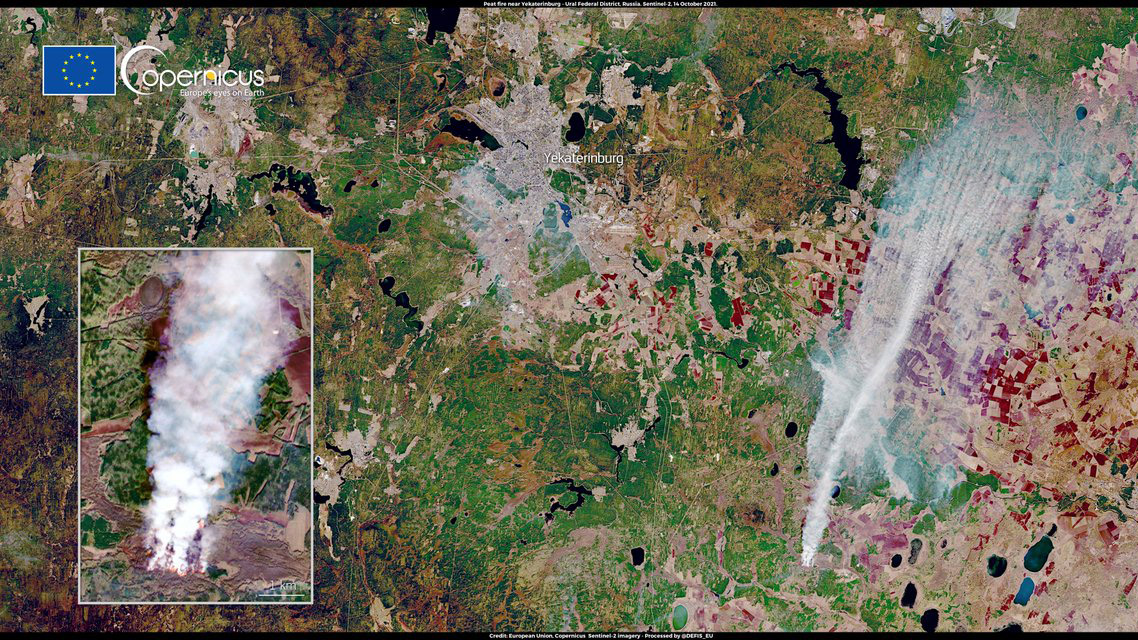
Friday, October 22, 2021: An image captured last week by a European satellite shows an unusual early winter peat fire near Russia's town of Yekaterinburg, raging well past the end of the wildfire season.
This year's wildfire season in Russia started early and produced a record amount of greenhouse gas emissions. As it appears, it is not yet over. While the majority of wildfires this summer were clustered in northeastern parts of Siberia, a new breakout has now been reported in the central region of Russia, north of Kazakhstan and the Ural mountain range.
In a statement, the E.U.'s Copernicus Earth observation program described the current wildfires, which are devouring local peat deposits, as "violent". Peatland fires are unusual at this time of year, according to Copernicus, and their presence makes Russia's 2021 wildfire season one of the longest in history. The fires are raging in spite of relatively cold temperatures below 50 degrees Fahrenheit (10 degrees Celsius). -- Tereza Pultarova
La Palma volcanic eruption: one month after
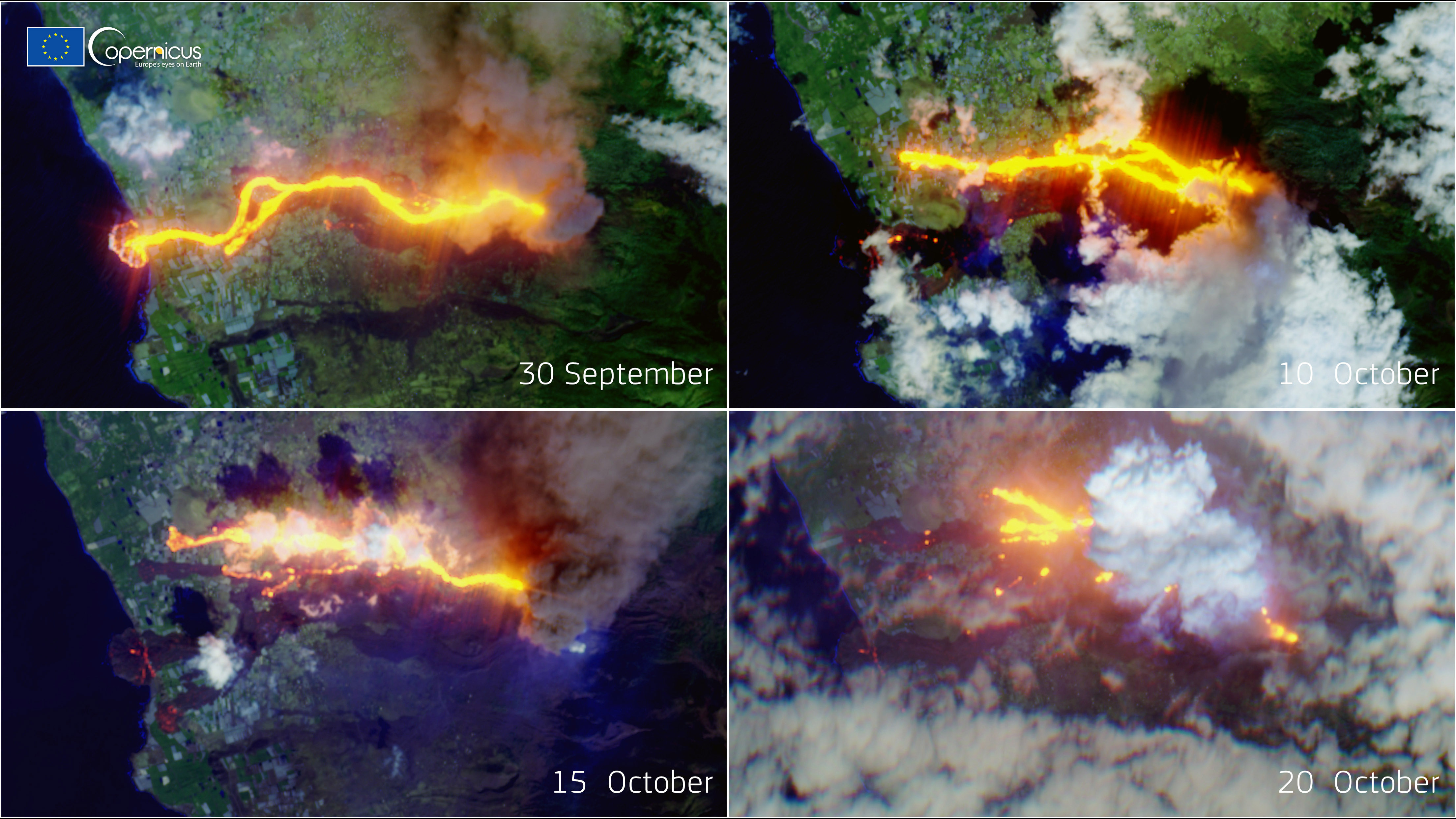
Thursday, October 21, 2021: One month after the onset of the La Palma volcanic eruption, a series of satellite images reveals how the unstoppable force of nature bulldozed swaths of the popular holiday island.
Satellites of the European Union's Copernicus Earth observation program have been monitoring the La Palma eruption since the Cumbre Vieja volcano first started spitting out lava on Sept. 19. A side by side comparison of images captured on Sept. 30 and Oct. 10, 15 and 20 by the Sentinel 2 satellite show the evolution of the lava flow as it found its way to the coast.
According to the latest data by the Copernicus Emergency Monitoring Service, 2,185 buildings have perished in the scorching lava, more than 200 in the last 48 hours. Over 3.3 square miles (8.5 square kilometers) of land have been submerged by the glowing molten rock.
The eruption, accompanied by mild Earth tremors, is still not showing any signs of letting up, Copernicus said in a statement.
In the images, a thick layer of ash can be seen covering areas around the volcano as well as infrastructure and dwellings.
The Copernicus Atmosphere Monitoring Service (CAMS), which monitors the spread of the sulfur dioxide plume emitted by the volcano, said today that pollution from Cumbre Vieja combined with Saharan dust caused air quality problems and lowered visibility as far as Puerto Rico and other areas of the Caribbean. -- Tereza Pultarova
Orion space capsule mounted on world's most powerful rocket

Wednesday, October 20, 2021: Preparations for the unmanned test mission to the moon and back are in full swing at NASA's Kennedy Space Center in Florida with the Orion capsule being integrated with the most powerful rocket ever built.
The Space Launch System (SLS) rocket, 322 feet high (100 meters), will launch the Orion capsule for its historic moon trip as part of the uncrewed Artemis I mission later this year or in early 2022.
On Tuesday (Oct. 19), the capsule and the rocket finally met inside the iconic Apollo-era Vehicle Assembly Building, where the SLS rocket had been assembled in summer.
The Orion capsule was moved from the neighboring Launch Abort System Facility on Monday, where its emergency crew-rescue system had previously been fitted and tested.
Late in the evening on Tuesday, engineers attached the Orion capsule to one of the five overhead cranes inside the Vehicle Assembly Building and began lifting it above the rocket. NASA said in a blog post earlier today that the capsule will be connected to the rocket's Orion Stage Adapter later today.
The Artemis I mission will test critical technology required for a human flight to the moon, which is currently scheduled for September 2023. -- Tereza Pultarova
Orion ready for rocket integration ahead of historic moon trip
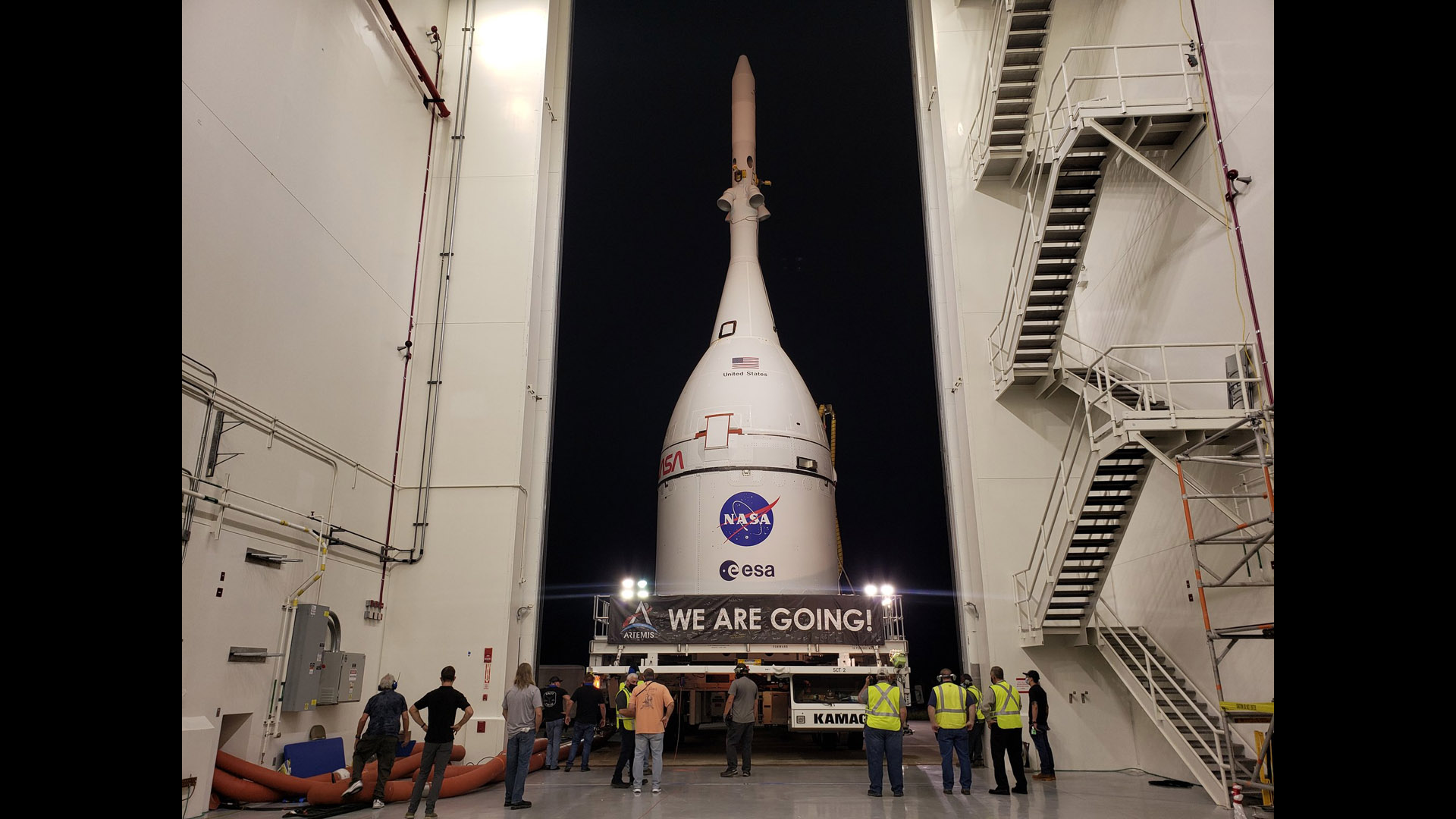
Tuesday, October 19, 2021: The Orion spacecraft that will fly to the moon and back in a few months' time to test critical technology ahead of a crewed mission in 2023 has been transported to the iconic Vehicle Assembly Building at NASA's Kennedy Space Center in Florida ahead of its integration with the Space Launch System Rocket.
The spacecraft, consisting of a crew capsule and a service module, has previously undergone a series of tests of its Launch Abort System, designed to bring a future crew to safety in case of a failure during launch or ascent.
The launch abort system, the long pointy structure atop the capsule, consists of three solid rocket motors that will push the capsule away from the potentially malfunctioning rocket. The Orion spacecraft is expected to launch for its debut moon-bound trip as part of the Artemis I mission either in late 2021 or in early 2022. The crewed mission, the first since the Apollo era to take humans to the moon, is expected to follow in September 2023. -- Tereza Pultarova
Russian film crew returns home

Monday, October 18, 2021: Russian actress Yulia Peresild, cosmonaut Oleg Novitsky and film director Klim Shipenko celebrate their return to Earth from the International Space Station after their historic mission.
Peresild and Shipenko, who arrived at the orbital outpost on Oct. 5, became the first professional film crew to fly to space and shoot a movie on board of the International Space Station. The movie, called the Challenge, tells a story of a heart surgeon (Peresild) sent on an emergency mission to the space station to perform a surgery on a cosmonaut stricken by a heart attack. The role of the ailing space farer went to Novitsky while his colleagues Peter Dubrov and Anton Shkaplerov played bit parts.
Dubrov and NASA astronaut Mark Vande Hei were originally expected to return to Earth with Novitsky but their missions were extended by another six months to accommodate the film project.
Peresild, Shipenko and Novitsky departed the space station at 9:13 p.m. EDT on Saturday (0135 GMT on Sunday) aboard the Russian Soyuz capsule. They landed safely in a Kazakh steppe three hours later. -- Tereza Pultarova
New high-res images of fiery La Palma volcanic eruption
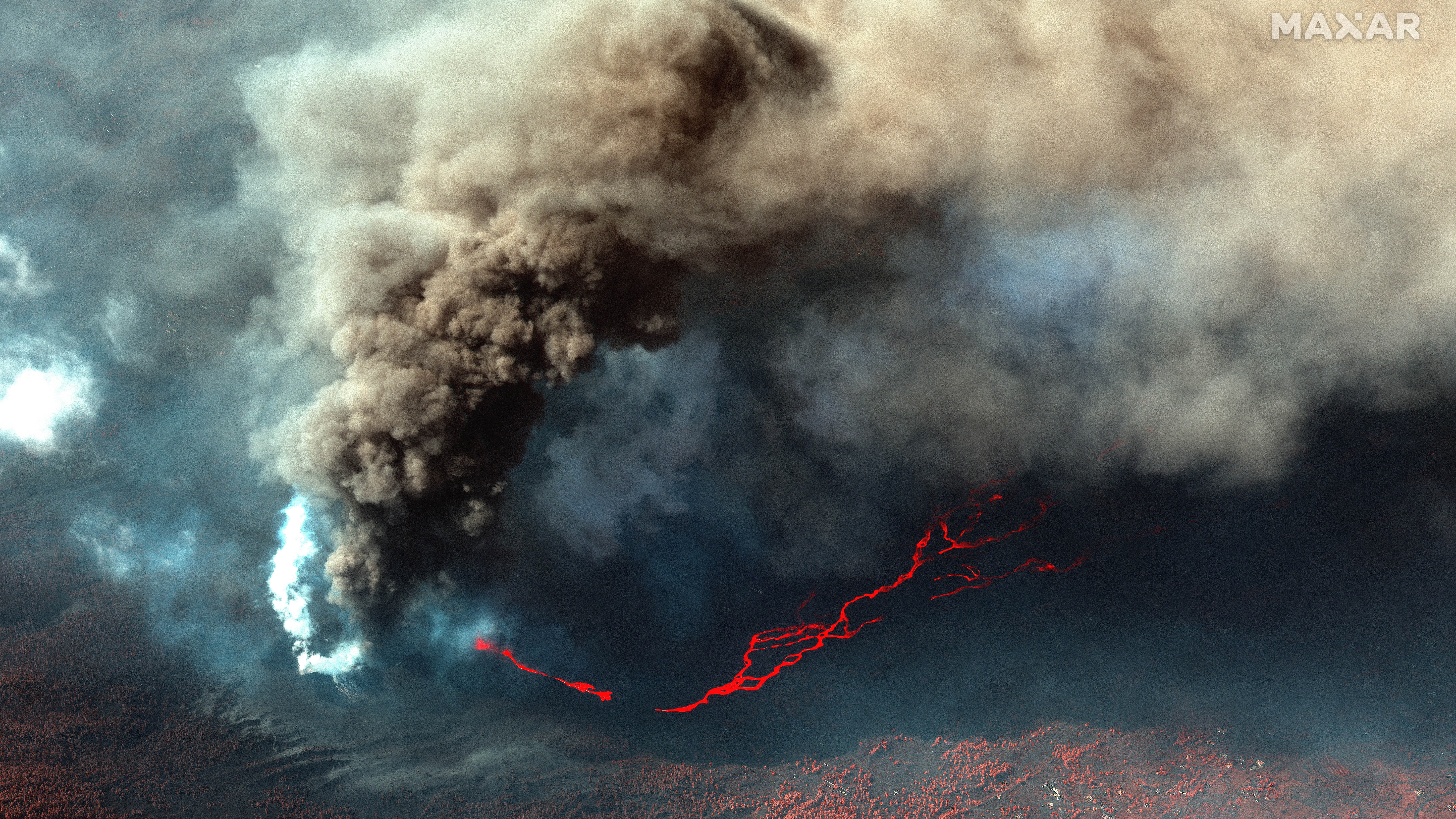
Thursday, October 15, 2021: New high-resolution satellite images reveal lava rivers spilling from the Cumbre Vieja volcano on the Spanish island of La Palma as the devastating eruption shows no signs of stopping nearly a month after it started.
The images, captured by a satellite of the U.S. Earth observation company Maxar Technologies on Thursday (Oct. 14), show the thick plume of smoke rising from the crater, forming a dark heavy cloud above the island. Glowing streams of lava flow down the flank of the mountain range towards the coast.
The Canary Islands Volcanology Institute (Involcan) shared terrifying footage from the ground on Friday (Oct. 15), showing a fast moving stream of scorching lava running past abandoned buildings.
"One of our crews was able to film a real lava "tsunami" today," Involcan tweeted. " Impressive speed and overflow of the lava channel."
But the infernal spectacle is far from entertaining for locals. According to the European Union's Copernicus Emergency Monitoring Service, 1,548 buildings have perished in the boiling lava since the beginning of the eruption on Sept. 19. More than 2.6 square miles (6.7 square kilometers) of land have been submerged while the volcano keeps spewing more lava without a pause.
The cloud of sulfur dioxide emitted by the volcano is spreading over Europe, reaching altitudes of up to 3.1 miles (5 kilometers), according to the Copernicus Atmosphere Monitoring Service (CAMS). It is expected to cross Europe from west to east over the coming days, CAMS senior scientist Mark Parrington said on Twitter. -- Tereza Pultarova
Captain Kirk in awe of planet Earth
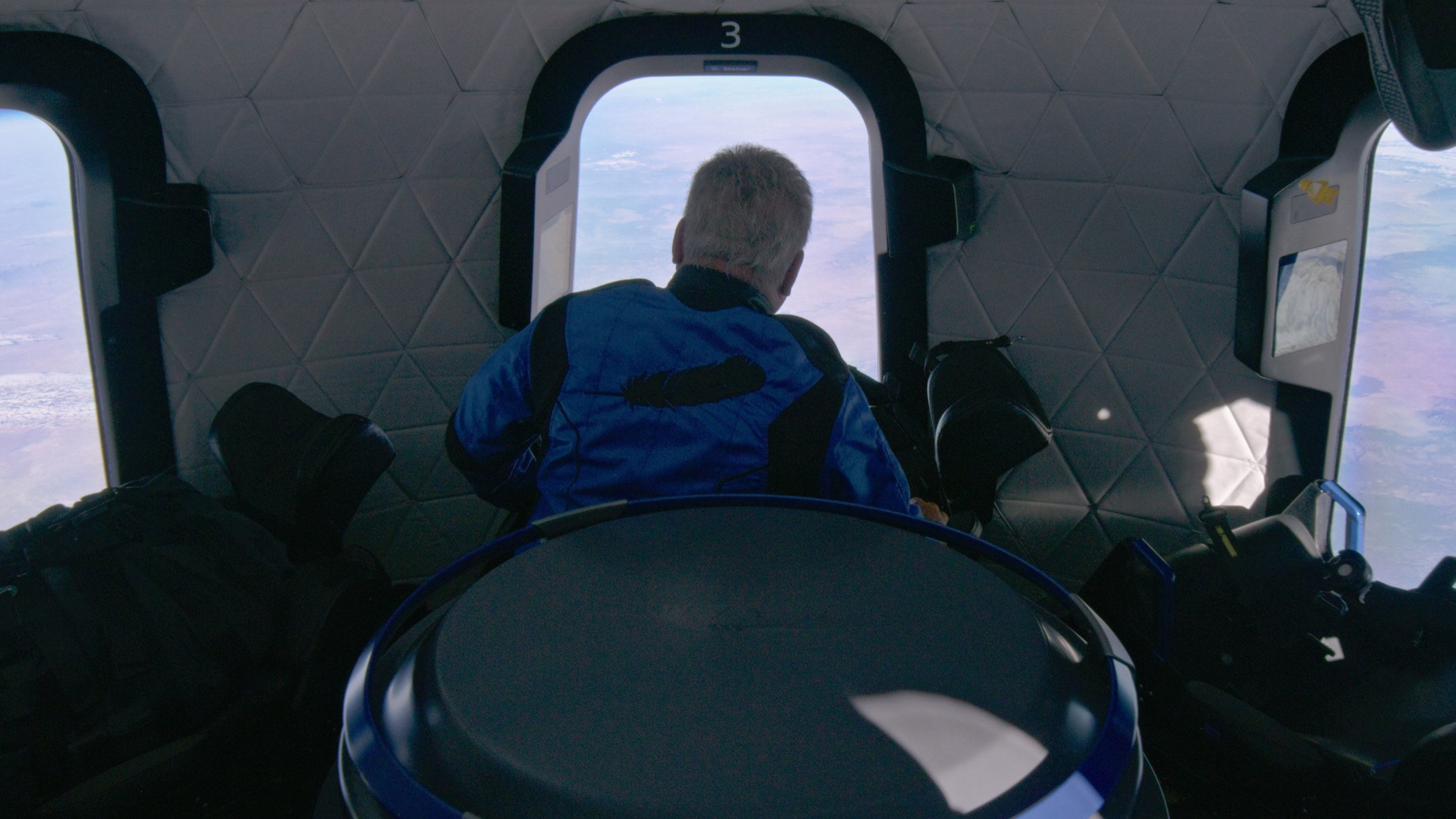
Thursday, October 14, 2021: Hollywood actor William Shatner who portrayed Captain Kirk in the original Star Trek series in the 1960s enjoys the view from the Blue Shepard capsule during his suborbital space trip in this image released by Blue Origin on Thursday (Oct. 14).
Shatner, who became the oldest person ever to fly to space at age 90, was reduced to tears by the experience.
"What you have given me is the most profound experience I can imagine," Shatner told Jeff Bezos, the founder of Blue Origin, which flew the actor to space on their second crewed flight on Wednesday (Oct. 13) "I'm so filled with emotion about what just happened ... it's extraordinary."
Shatner was accompanied for his space ride by Glen de Vries, vice chair for life sciences and healthcare at the French software company Dassault Systèmes and Chris Boshuizen, co-founder of the Earth-observation company Planet. Also with them was Audrey Powers, Blue Origin's vice president of mission and flight operations. -- Tereza Pultarova
Brain of spacecraft that will return humans to moon heads to U.S.

Wednesday, October 13, 2021: The Europe-built service module for the Orion spacecraft that will take humans to the moon in 2023 has departed Germany for Kennedy Space Center to commence integration with the crew capsule.
The European Service Module for the Artemis II mission, the first with human crew on board, was built by a consortium of European companies led by aerospace giant Airbus. The module, which has been assembled in the city of Bremen in the north of Germany, was loaded into an Antonov aircraft on Wednesday (Oct. 13) and dispatched to the U.S. for integration with the Orion crew capsule at the Kennedy Space Center in Florida.
Once the two components are mated together, the spacecraft will undergo extensive testing ahead of its launch to the historical trip to the moon, which is now scheduled for September 2023.
The European Service Module provides propulsion and power for the spacecraft but also handles life support and thermal control for the four astronauts inside the capsule. The first Europe-built Orion service module is currently waiting for its debut trip without a crew, which is expected to take place later this year or in early 2022. -- Tereza Pultarova
James Webb Telescope arrives at launch site

Tuesday, October 12, 2021: The James Webb Telescope has arrived in French Guiana today aboard the MN Colibri cargo ship after a 1,500-mile (2,400 kilometers) voyage from California.
James Webb, the largest and most complex space science observatory ever built, survived 16 days at sea sealed inside a custom-built, environmentally controlled container.
The telescope will now be transported to the European Spaceport in Kourou to begin preparations for its Dec. 18 launch atop an Ariane 5 rocket.
The telescope's journey started on Sept. 24 when it departed the facilities of aerospace company Northrop Grumman in Redondo Beach, California, accompanied by a police escort. It was driven through the streets of Los Angeles to Naval Weapons Sea Beach where it was loaded onto the MN Colibri.
The ship then sailed down the Pacific coast of central America to Panama, where it slipped through the Panama Canal into the Caribbean Sea and down the coast of Venezuela to its destination.
The telescope, a partnership between NASA, the European Space Agency and the Canadian Space Agency, was conceived in the early 1990s as a successor of the legendary Hubble Space Telescope. Once operational, Webb will look into the most distant universe and reveal unprecedented information about the earliest phases of its evolution. It will also search for habitable worlds around other stars and attempt to answer some of the longstanding questions about the physics governing the universe, such as proving the existence of dark matter.
"The James Webb Space Telescope is a colossal achievement, built to transform our view of the universe and deliver amazing science," NASA Administrator Bill Nelson said in a statement. "Webb will look back over 13 billion years to the light created just after the big bang, with the power to show humanity the farthest reaches of space that we have ever seen. We are now very close to unlocking mysteries of the cosmos, thanks to the skills and expertise of our phenomenal team.! -- Tereza Pultarova
Giant dust devil whirls across Martian plains
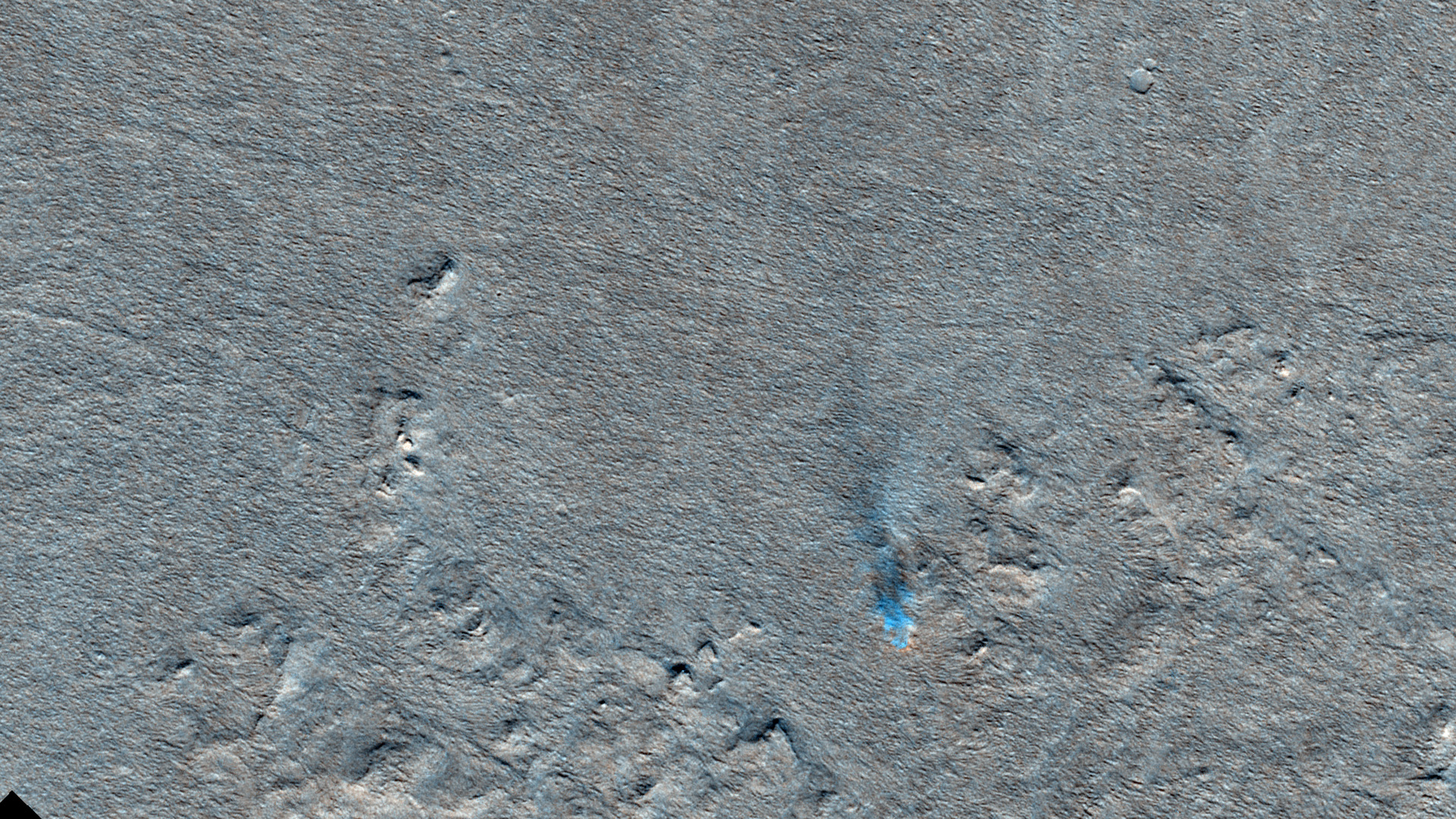
Monday, October 11, 2021: A dust devil whirling across the surface of Mars' Amazonis Planitia can be seen in this image taken by the European/Russian ExoMars Trace Gas Orbiter in May this year.
The false-color composite photo, taken by the satellite's CaSSIS camera, shows the wind vortex in blue and its trail.
Dust devils frequently form in late spring and summer in Amazonis Planitia, one of the smoothest areas of Mars, which is located north of the planet's northern tropic. The mechanism behind the dust devil formation on Mars is the same as on Earth, except that those on Mars can grow into sizes much greater than the most damaging tornadoes on Earth. In some cases, they can reach up to 5 miles (8 kilometers) high.
The Amazonis Planitia can give rise to several dust devils every afternoon during the warm season. As the sun's rays warm the ground, the hotter air starts to rise from the surface creating an updraft. The cooler air from above sinks down to fill the place of the hot air, triggering a vertical vortex. When this vortex interacts with a horizontal gust of wind, a travelling dust devil forms. When the speed of the vertical vortex accelerates enough, the rising air starts lifting up dust from the surface, creating a visible trail, or a dust track, in its wake.
This image, taken on May 19 this year, which is the middle of spring on the northern hemisphere of Mars, was released by the European Space Agency (ESA) on Monday (Oct. 11) -- Tereza Pultarova
New images reveal scale of La Palma eruption

Friday, October 8, 2021: New satellite images of the Spanish island of La Palma reveal a broad swath of lava flowing down the flank of the erupting Cumbre Vieja volcano into the Atlantic Ocean where a new peninsula has formed since the lava reached the coast last week.
The images, taken on Thursday (Oct. 7) by satellites of U.S. Earth observation company Maxar Technologies, provide a natural-color view of the scene.
The eruption, which started on Sept. 19, has already destroyed more than a thousand buildings. The European Copernicus Earth observation program reports that the sulfur dioxide plume from the volcano has already spread to the U.K. and is about to reach the Caribbean. -- Tereza Pultarova
Ship tracks in the Pacific Ocean from space

Thursday, October 7, 2021: A Weather forecasting satellite captures the formation of ship tracks in the atmosphere above the northern Pacific Ocean.
The false-color imagery, captured by the Geostationary Operational Environmental Satellite (GOES) West satellite operated by the U.S. National Oceanic and Atmospheric Administration (NOAA) on Oct 5 and 6, reveals moving streaks above the ocean surface, which are caused by aerosol particles from the ship exhaust. These aerosol particles act as cloud condensation nuclei around which moisture from the atmosphere can condense.
First observed in 1965, ship tracks help scientists study how human-made emissions affect the climate, which is difficult to study in polluted urban areas. -- Tereza Pultarova
Cyclone dumps year's worth of rain in Arabian desert
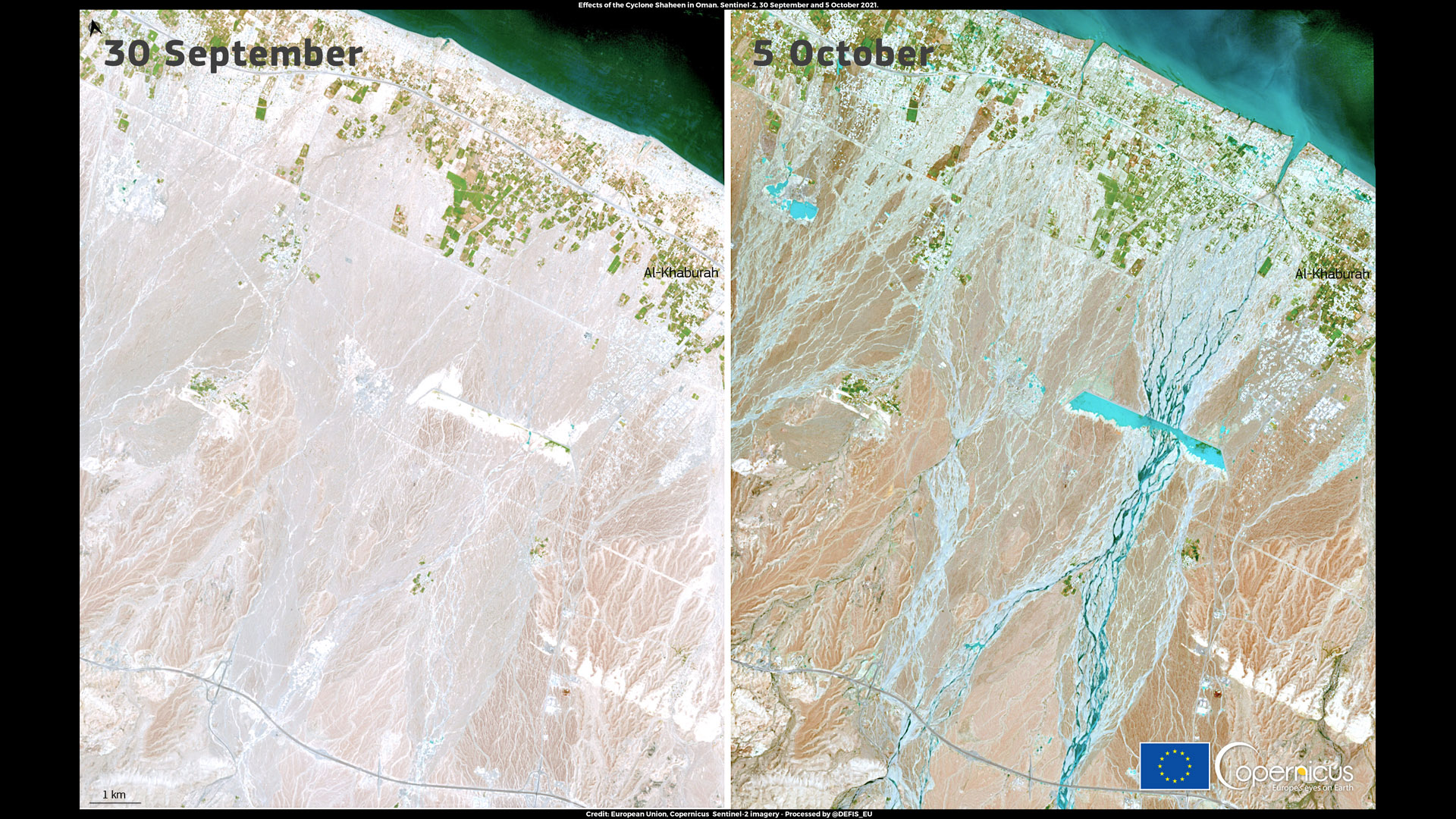
Wednesday, October 6, 2021:Coastal desert areas along the Gulf of Oman can be seen submerged in water after Cyclone Shaheen dumped a year's worth of rain on the area earlier this week.
The two images taken by the European Copernicus Sentinel-2A and Sentinel-2B satellites on Sept. 30 and Oct. 5 show the coast of Oman in the north-eastern parts of the Arabian Peninsula before and after the deluge.
Shaheen, the first cyclone in history to hit Oman originally formed above the Bay of Bengal as Cyclone Gulab and brought heavy rain to northeast India. It then disintegrated while crossing the Indian sub-continent only to reform again above the warm Arabian Sea. The revitalized tropical storm, renamed as Shaheen, then made landfall on Sunday (Oct. 3) near the town of al-Khaburah, west of Oman's capital Muscat, accompanied by 150 km/h winds.
According to Yale Climate Connection, Shaheen dumped more than one year's worth of rain on the area, causing widespread flooding along the coast. The city of Al-Marat, where the average annual rainfall amounts to some 3.5 inches (90 millimeters) per year, reported 14.5 inches (369 millimeters) of rain.
At least 13 people have died in the floods and ensuing landslides. Shaheen is moving further to the west and disintegrating. It is still expected to bring heavy rain and strong winds to the United Arab Emirates where residents in several areas have been advised to stay indoors. -- Tereza Pultarova
Russian actress headed to International Space Station

Tuesday, October 5, 2021: Russian actress Yulia Peresild strapped inside the Soyuz capsule shortly before the launch to the International Space Station on Tuesday at 4:55 a.m. EDT (0855 GMT).
Peresild and movie director Klim Shipenko are the first professional film makers to visit the orbital outpost. During their two-week stay, they will film a movie called The Challenge. The film's plot involves an astronaut getting a heart attack during a space walk and a surgeon being sent to the space station to perform emergency surgery before the stricken space farer could be returned to Earth.
The two artists launched to the space station with veteran cosmonaut Anton Shkaplerov from Russia's Baikonur Cosmodrome in Kazakhstan atop a Soyuz 2.1a rocket that was specially decorated for the movie.
Peresild and Shipenko will return to Earth with cosmonaut Oleg Novitsky on Oct. 17. To accommodate the film, the stays of Russian cosmonaut Peter Dubrov and NASA astronaut Vande Hei stays were extended for another six months. They will land with Shkaplerov in March, after 365 days in space. Vande Hei will have completed the single longest spaceflight by an astronaut in U.S. history. -- Tereza Pultarova
Satellite watches first ever cyclone bring flash floods to Arabian desert

Monday, October 4, 2021: The first cyclone in history bringing flash floods to the desert-covered Arabian Peninsula is seen in this video captured by a European weather forecasting satellite.
The cyclone, called Shaheen, originally formed above the Bay of Bengal as Cyclone Gulab and brought heavy rain to northeast India. It then disintegrated while crossing the sub-continent only to reform again above the warm Arabian Sea as Cyclone Shaheen.
The cyclone, captured in this video by the European Meteosat satellite, made landfall yesterday in North West Oman, bringing torrential rain and up to 93 mph (150 km/h) winds to the country's capital Muscat, where it killed at least four people. The storm brought about 500 mm of rain in a few hours where usual annual rain averages amount to less than 100 mm per year.
The cyclone now began to disintegrate again but is still expected to cause disruption as it moves westward through the Gulf of Oman toward the United Arab Emirates.
According to meteorologists, only four tropical storms since 1950, made landfall in Oman but none has made it this far into the Gulf of Oman while maintaining such an intensity. -- Tereza Pultarova
Typhoon Mindulle looks pretty from space but is actually wreaking havoc in Japan
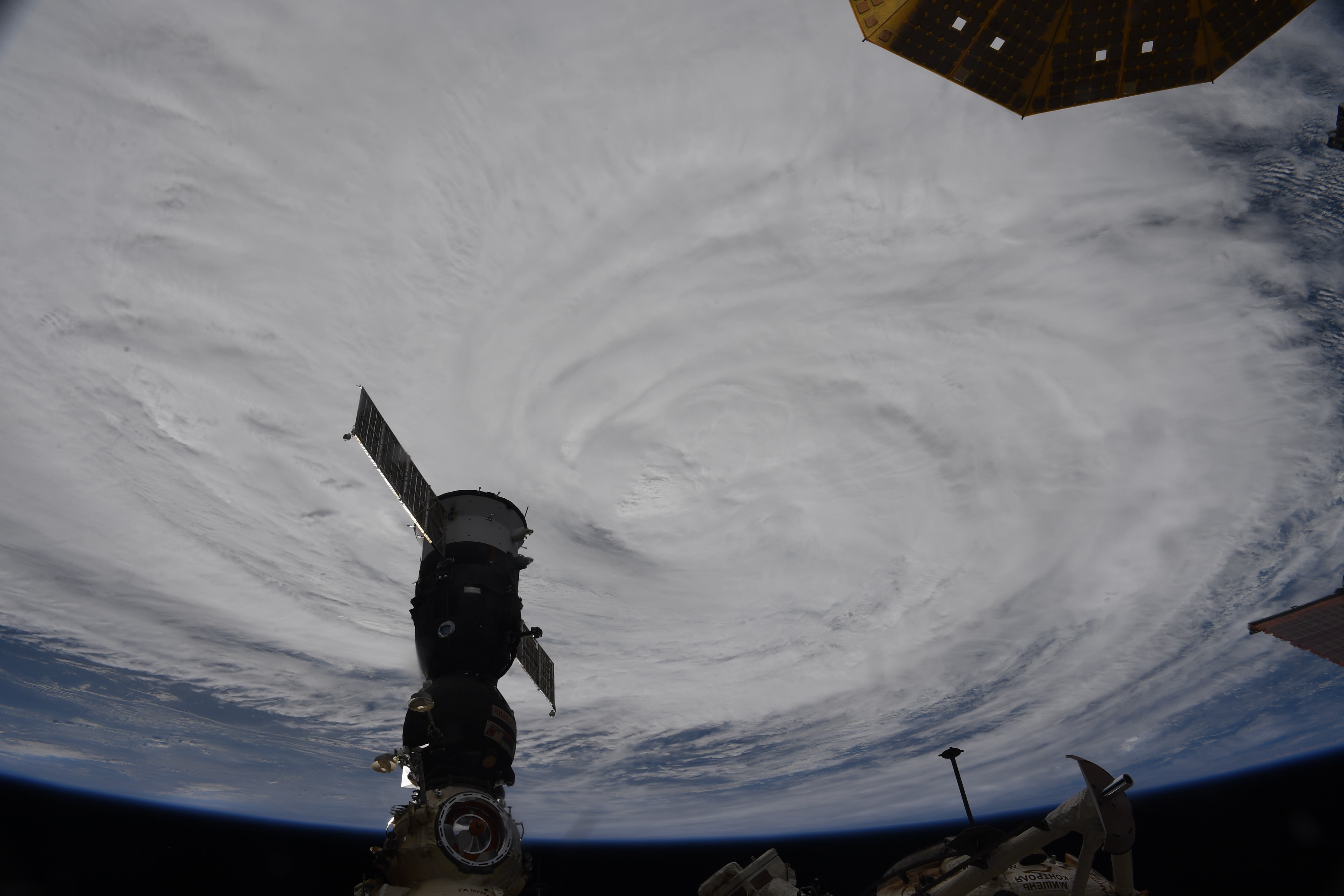
Friday, October 1, 2021: The creamy swirl of Typhoon Mindulle can be seen in this image taken by Japanese astronaut Akihiko Hoshide from the International Space Station.
Mindulle, also called Typhoon No. 16, brought strong winds and heavy rain to the Pacific coast of eastern Japan on Friday (Oct.1), causing disruption to airlines and train services, according to local media.
"Typhoon No. 16 approaches Japan. Everyone, please be careful," Hoshide tweeted early in the morning on Friday.
With sustained winds of nearly 75 mph (120 km/h) and gusts of up to 95 mph (150 km/h), Mindulle will move further to the north over the weekend and will continue affecting weather in the northeast of Japan in the upcoming days. -- Tereza Pultarova
Asteroid explorer Lucy prepared for launch

Thursday, September 30, 2021: NASA's asteroid explorer Lucy is being encapsulated into a rocket fairing ahead of its launch on Oct. 16.
Lucy is the first spacecraft ever to explore the so-called Trojan asteroids, space rocks orbiting the sun in the orbit of Jupiter. The spacecraft, named after a fossilized australopithecus skeleton and a Beatles song, will embark on its 12-year journey from Cape Canaveral atop a United Launch Alliance Atlas V rocket.
During its landmark mission, Lucy will study up close eight different asteroids. Before it reaches its destination, it will take a close-up look at a space rock named Donaldjohanson, after the anthropologist that discovered the famous Lucy skeleton. Lucy will zoom past Donaldjohanason, located in the main asteroid belt between the orbit of Mars and Jupiter, in 2025.
In 2027, it will finally reach the orbit of Jupiter and commence its tour of the Trojan asteroids. -- Tereza Pultarova
First images of International Space Station with Nauka module released by Roscosmos
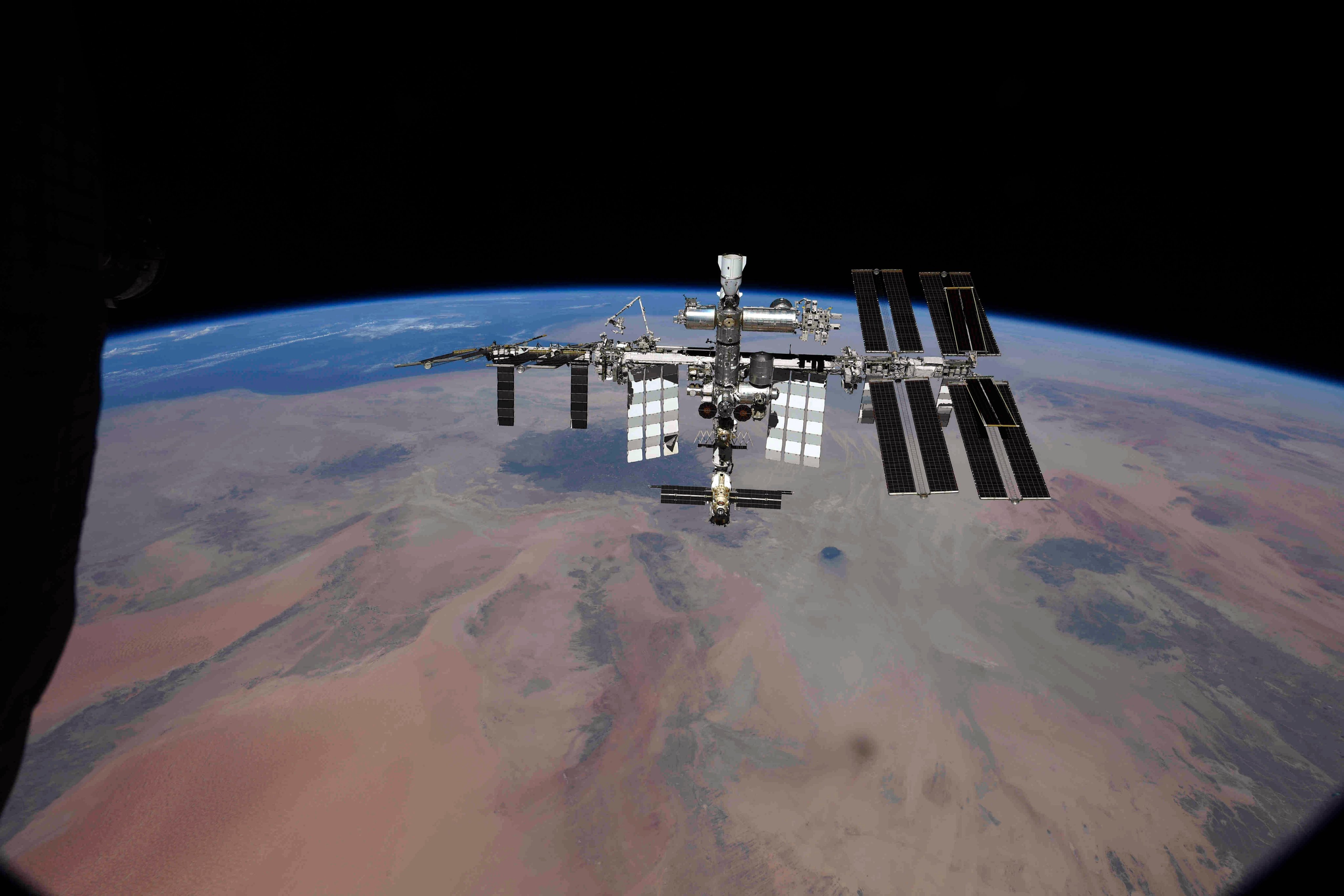
Wednesday, September 29, 2021: The first images of the International Space Station with the Nauka module attached, taken during a relocation of the Russian Soyuz capsule on Tuesday (Sept. 28), have been released by the Russian Space Agency Roscosmos.
Cosmonaut Oleg Novitsky, who piloted the Soyuz capsule during the relocation, shared the images on Twitter on Wednesday (Sept. 29).
"Yesterday, we re-docked the Soyuz MS-18 manned spacecraft from the Rassvet module to the new Nauka module," Novitsky said. "All according to plan! We managed to take unique images of the ISS in the new configuration."
Cosmonaut Pyotr Dubrov took the images and a short video during the 40-minute relocation maneuver designed to free room on the Rassvet module for the Soyuz MS-19 capsule that will bring a Russian actress and a film director to the orbital outpost next week. The cosmonauts had to make a brief detour that took them 380 feet (120 meters) above the U.S. segment of the station to take the overview shots. -- Tereza Pultarova
Weather satellite captures launch of NASA's new Earth-watching spacecraft

Tuesday, September 28, 2021: The Goes 17 weather-forecasting satellite captured the moment when an Atlas V rocket with NASA's new Earth observation spacecraft Landsat 9 aboard lifted off from Vandenberg Space Force Base in California on Monday (Sept. 27).
Perched 22,000 miles (36,000 kilometers) above Earth's surface with a stable view of the American continent, Goes 17, operated by the National Oceanic and Atmospheric Administration, detected the streak created by the rocket as it sped through Earth's atmosphere in its water vapor channel.
Landsat 9 will be the ninth and most advanced satellite to study Earth from above for the Landsat program, a joint effort by NASA and the U.S. Geological Survey that has provided constant imagery of our planet for nearly 50 years. It carries a high-resolution camera and a sensitive infrared sensor that together can image the Earth across 11 spectral bands and resolve objects down to about 50 feet (15 meters) wide. The satellite should orbit the Earth at an altitude of about 438 miles (705 kilometers) over the planet's poles. -- Tereza Pultarova
Space tourists planting trees before trip to space station
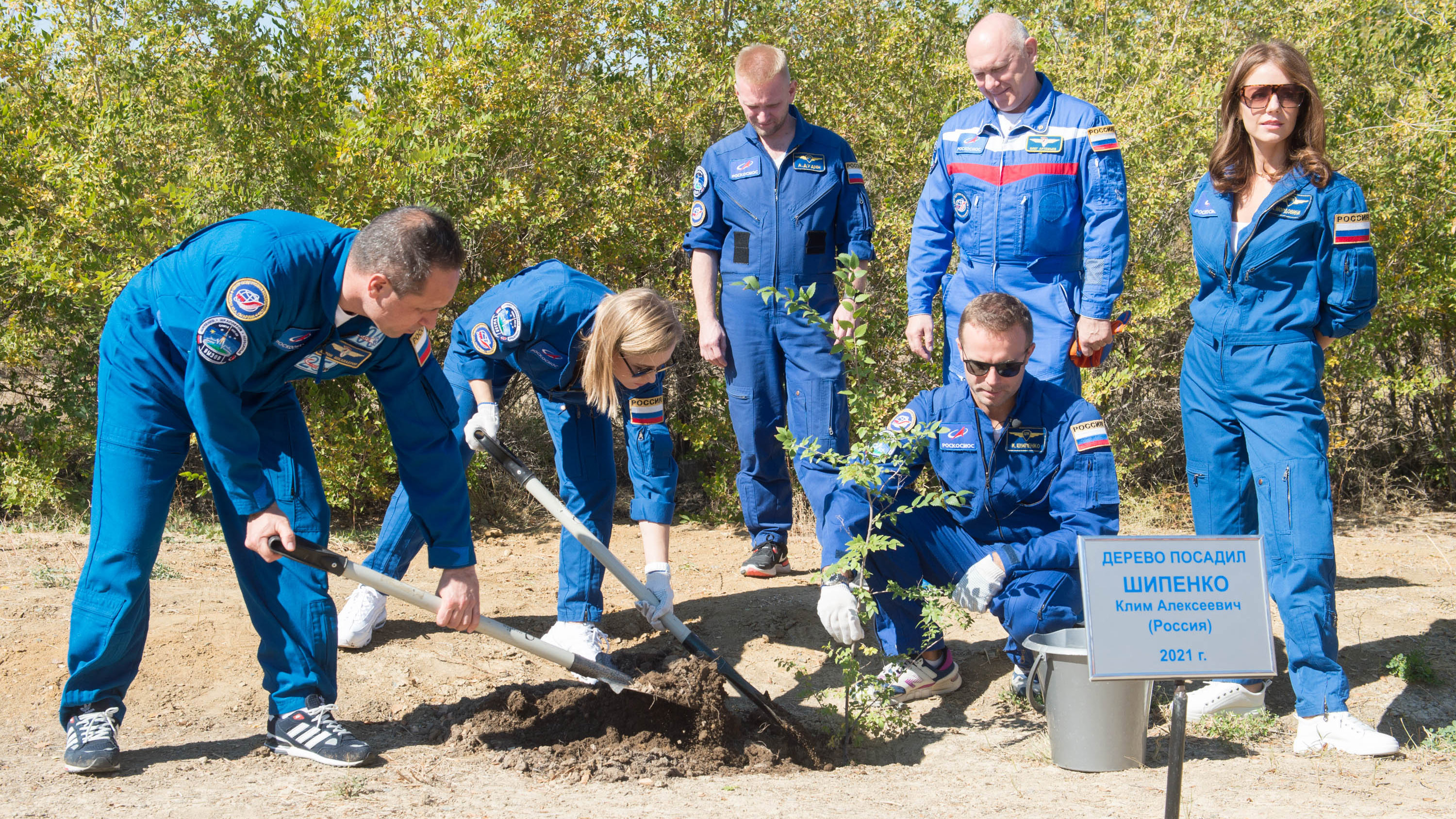
Monday, September 24, 2021: Russian actress Yulia Peresild and movie director Klim Shippenko plant trees at Russia's Cosmodrome Baikonur in Kazakhstan as part of a preflight ritual in an image shared by Russian cosmonaut Anton Shkaplerov on Twitter today (Sept.27).
Peresild and Schippenko will spend three weeks at the International Space Station filming a movie called The Challenge. They are scheduled to launch on Oct. 5 together with Shkaplerov on board Russia's Soyuz MS-19. They are expected to return to Earth on Oct. 17 with the current ISS commander Oleg Novitskiy.
"Eight days before launch: all crews strictly follow preflight traditions," Shkaplerov said in the Tweet. "One of them is related to the Alley of Cosmonauts, which is located next to Site 17 at the Baikonur Cosmodrome. First-timers plant a tree, and today was the turn of Yulia Peresild and Klim Shippenko."
Shkaplerov will remain on the orbital outpost until March next year. -- Tereza Pultarova
ExoMars orbiter provides glimpse into Mars' geological history

Friday, September 24, 2021: Layers of deposits inside a Martian crater can be seen in this image captured by the European Space Agency's (ESA) ExoMars Trace Gas Orbiter, providing a glimpse into the geological history of the planet and the erosion processes on its surface.
The image, captured on April 21 this year and released on Sept. 24, shows sediments inside the 30-mile-wide (50 km) crater located near the planet's equator which was likely created by an asteroid impact.
The lower layers of dark sand contrast with the brighter wind-eroded sedimentary rocks on top. In places faults created in past surface fractures cut through the layers creating gaps.
The ExoMars Trace Gas orbiter arrived at Mars in 2016 together with the Schiaparelli lander, which crashed during an unsuccessful landing attempt due to a computer glitch. In addition to imaging the planet's surface with its CaSSIS camera, the orbiter also samples Mars' atmosphere with unprecedented accuracy. The orbiter will also serve as a communication node connecting the ESA/Roscosmos Rosalind Franklin rover with Earth. The rover, which has been delayed several times, is now scheduled for launch next September. -- Tereza Pultarova
Day and night on Earth on autumnal equinox 2021
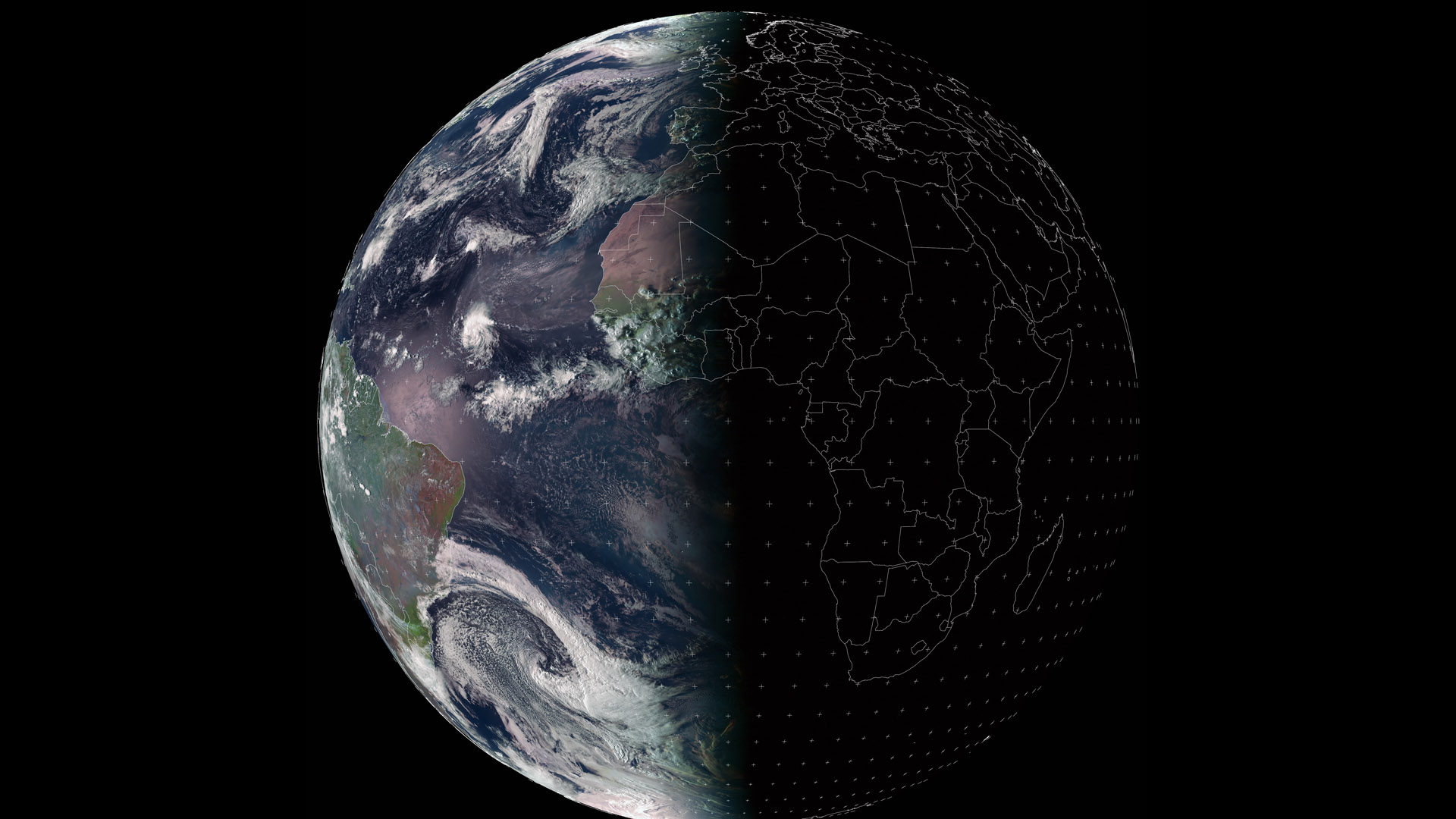
Thursday, September 23, 2021: The planet Earth seen on the Autumnal Equinox on Wednesday (Sept. 22) from 22,000 miles away by a European weather forecasting satellite.
The image, taken at 18:00 UTC, shows the planet split in equal halves along its north-south axis. While the eastern half, including most of Africa and Europe, is already submerged in the dark, the Atlantic Ocean and Americas are bathed in sunlight.
On the equinox, which happens twice a year, the Earth's axis, tilted by 23.5 degrees with respect to the plane in which the planet orbits, appears perpendicular with respect to the sun. As a result of that, the Southern and Northern hemispheres receive the exact same amount of sunlight. The day is a perfect 12-hours long all over the globe on these two days. The Autumnal Equinox marks the beginning of the fall and winter seasons in the Northern Hemisphere. The day will continue to shrink and with it, colder weather will arrive. In the Southern Hemisphere, the situation is exactly opposite. The next annual astronomical milestone, the Winter Solstice, will take place on Dec. 21. From that day on, the length of the day in the Northern Hemisphere will start to creep up again. It will match the length of the night on Spring Equinox on March 21 and continue to increase up to the Summer Solstice on June 21. -- Tereza Pultarova
Astronaut captures La Palma volcano glowing in the blackness of the night

Wednesday, September 22, 2021: European astronaut Thomas Pesquet captured this image of the erupting Cumbre Vieja volcano on the La Palma island from the International Space Station.
The image, shared on Pesquet's Twitter account on Wednesday (Sept. 22), shows glowing lava streaming from the crater surrounded by the dark Atlantic Ocean off the coast of West Africa.
"The #LaPalma volcano in eruption. Set against the blackness of the surrounding Atlantic Ocean, the bright orange glow is even more impressive," Pesquet said in the Tweet.
Cumbre Vieja erupted on Sunday (Sept.19) for the first time since 1971. The eruption was preceded by more than 22,000 mild earthquakes, which alerted scientists to the magma bubbling up inside the volcano.
The slow-moving but unstoppable rivers of boiling lava have since destroyed over 300 houses and forced the evacuation of more than 6,000 people. Geologists worry the scorching lava might cause explosions and release toxic gas once it reaches the coast and mixes with the cool sea water. -- Tereza Pultarova
Satellite watches as holiday island volcano erupts after half a century
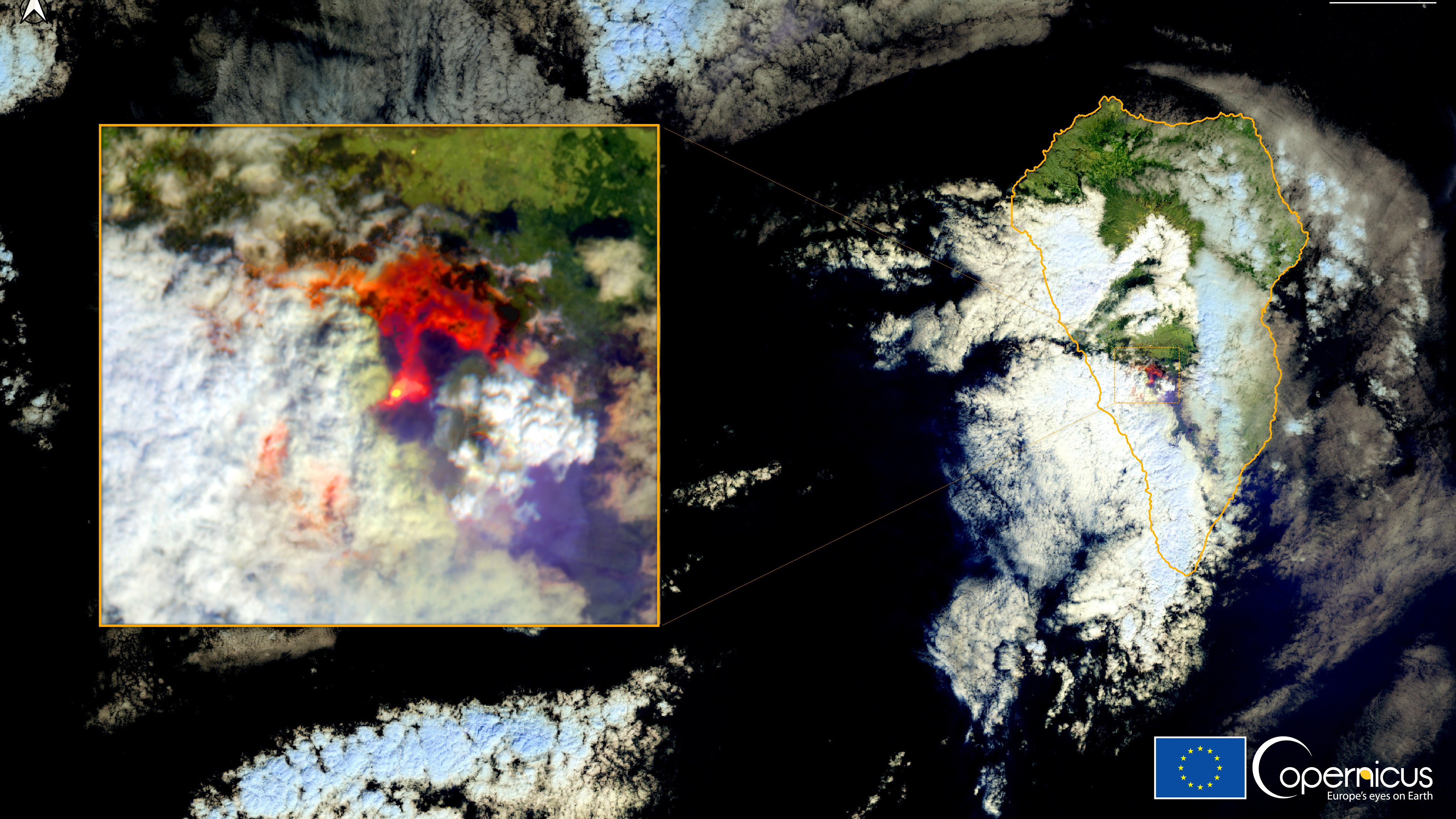
Tuesday, September 21, 2021: The Cumbre Vieja volcano on the Canary island of La Palma, west off the coast of Morocco, erupted for the first time since 1971 on Sunday (Sept.19). The European Sentinel-2 satellite captured the plume of smoke and streams of lava spilling from the volcano towards the western flank of the island on Monday (Sept.20) .
Sentinel-2 is part of the European Earth observation program Copernicus. Scientists working with the data have revealed this morning that the eruption has already destroyed 166 buildings in the Los Llanos de Aridane region as it spread towards the coast. The lava, according to this morning's estimates, now covers an area of about 103 hectares. Some 6,000 people have been evacuated and further evacuations are under consideration as geologists fear the more than 1,000 degrees C (1,800 degrees F) lava might trigger dangerous explosions and release toxic gas once it reaches the coast and mixes with the sea water, according to The Independent.
Scientists also monitor the spread of the volcanic ash and sulfur dioxide released by the eruption into the atmosphere. According to the Copernicus Atmosphere Monitoring Service (CAMS), the plume will spread northwards over the coming days and reach central France by the end of this week. -- Tereza Pultarova

Monday, September 20, 2021: Inspiration4 crew members posed for this group selfie in front of the dome window of their Dragon Crew capsule during their historic three-day all-civilian space trip.
At first glance, the image might seem rather ordinary. The clouds against the blue in this image, however, are seen from above, and the blue is not the blue of the sky but that of the ocean.
Inspiration4, the first ever all-civilian space mission successfully landed on Saturday (Sept. 18) evening. All crew members appeared in good spirits, despite reported problems with the spacecraft's toilet. -- Tereza Pultarova
Cancer survivor relishes space views from Dragon's cupola
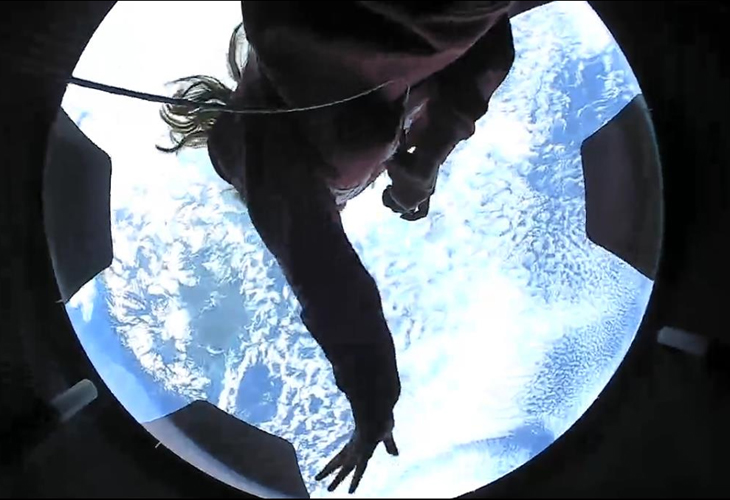
Friday, September 17, 2021: Cancer survivor and civilian astronaut Hayley Arceneaux can be seen floating inside Dragon Crew's dome window, enjoying spectacular views of Earth during the first-ever all-civilian space mission Inspiration4.
Hayley is one of the four amateur astronauts on the historic three-day space trip. A physician assistant at the St. Jude Children's Research Hospital, where she herself used to be a patient, 29-year-old Hayley is the youngest American ever to fly in space. She is also the first ever space traveller with prosthetic body parts.
The St. Jude Children's Research Hospital is the benefactor of charitable proceeds from the mission, including a ticket raffle and an in-orbit fundraising performance by Hayley's colleague Chris Sembroski.
Inspiration4 launched from the NASA Kennedy Space Center in Florida on Wednesday (Sept. 15) at 8:02 p.m. EDT (0002 GMT). The crew is expected to splash down off the coast of Florida or in the Gulf of Mexico on Saturday (Sept. 18) -- Tereza Pultarova
Falcon 9 shooting up the sky with Inspiration4 crew members atop
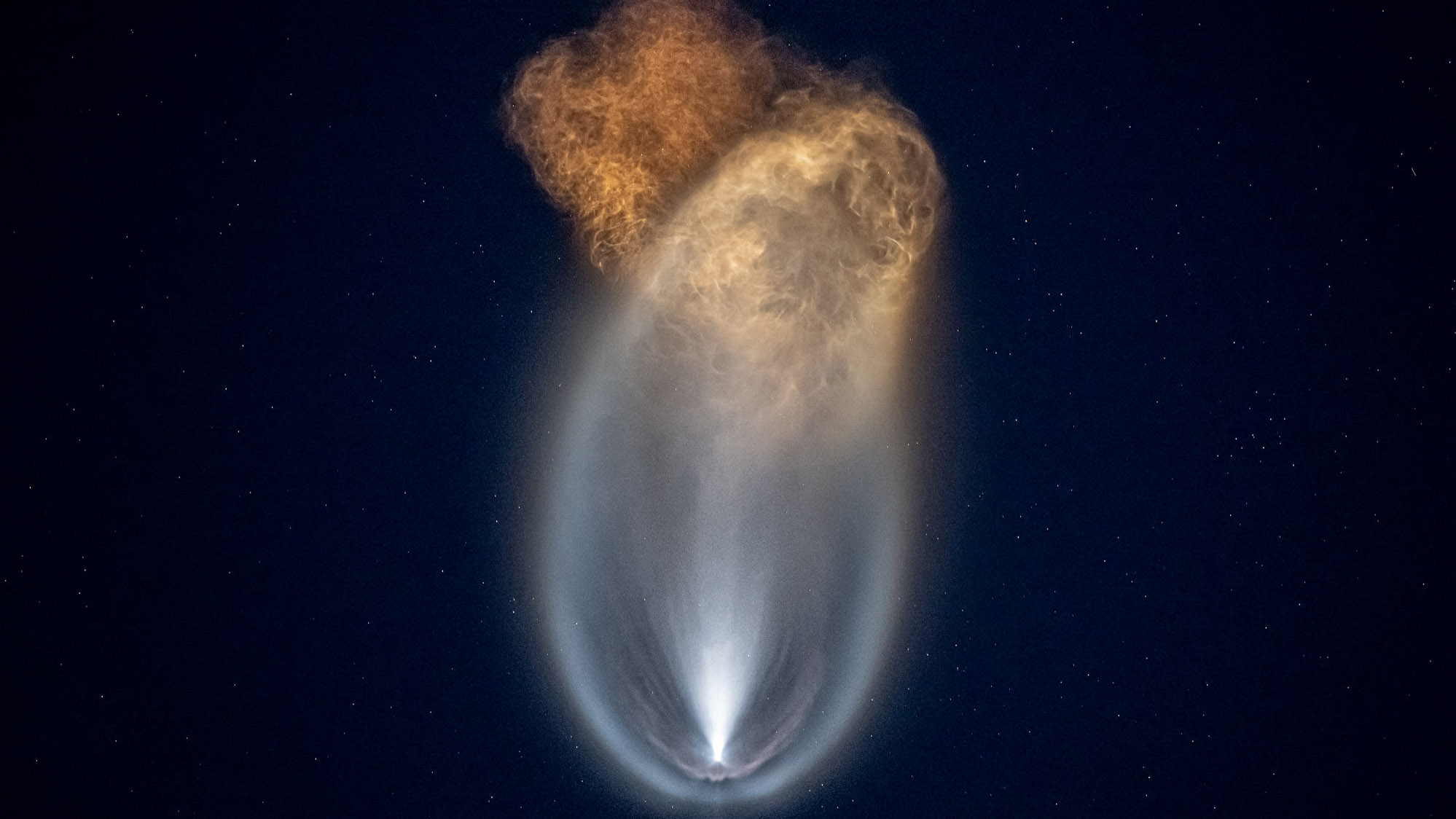
Thursday, September 16, 2021: The plume of fumes generated by the SpaceX Falcon 9 rocket carrying four civilian astronauts of the Inspiration4 mission on their historic orbital trip was captured by photographer John Kraus shortly after the mission's lift-off from NASA's Kennedy Space Center in Florida.
The plume, backlit by the setting sun, was visible to observers from dozens of miles away as the rocket with entrepreneur Jared Isaacman, geoscientist Sian Proctor, physician assistant Hayley Arcenaux, and data engineer Chris Sembroski hurtled towards the sky.
The crew, which is expected to conduct scientific experiments and even sing and play ukulele to raise money for charity, is expected to splash down in the Gulf of Mexico on Saturday (Sept. 18). No update about the mission's progress has been shared since the launch at 8 pm EDT on Wednesday (Sept. 15). -- Tereza Pultarova
New Earth-observation satellite trains its eyes on the moon
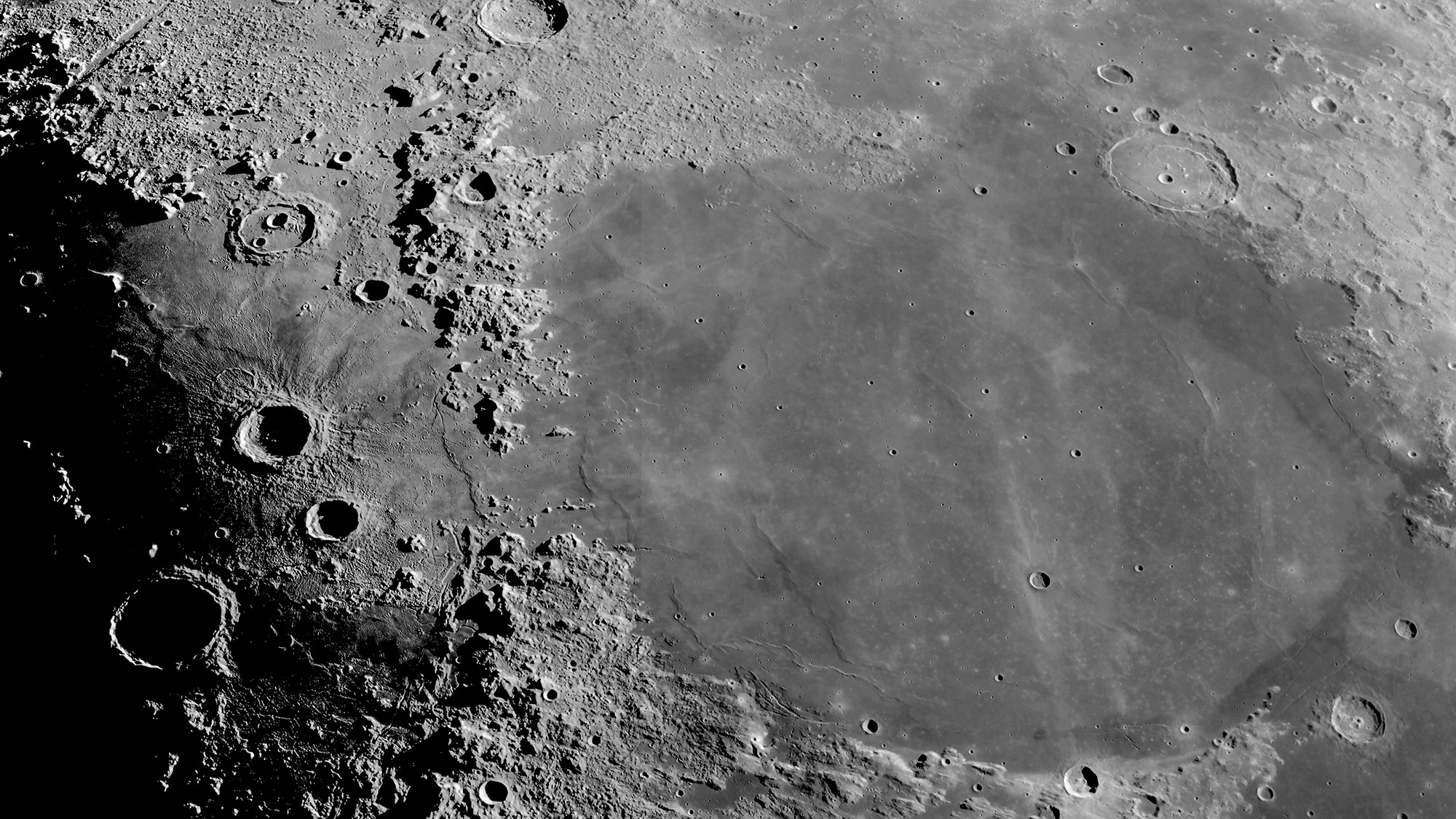
Wednesday, September 15, 2021: This stunning image of the moon's surface has been captured by the recently launched Earth-observing satellite Pleiades Neo.
The satellite's operators used the Earth's natural companion to calibrate its sensors so that it can subsequently obtain perfect images of our home planet. Moon is apparently a great object for such checks because its surface looks almost smooth and reflects sunlight in a rather consistent way. Both Pleiades Neo satellites that are currently in orbit can look at the moon at about the same time, which enables the operators to ensure their images are of the same quality.
The image was released by the European Aerospace firm Airbus, which built and operates the two Pleiades Neo satellites, last week. The satellites, launched in April and August this year, image the surface of Earth with a resolution of 12 inches (30 centimeters). This level of resolution enables, for example, counting the number of people in the images.
Orbiting at the altitude of 385 miles (620 kilometers) above the planet's surface, the satellites cover an 8.6-mile-wide (14 km) swath of land in one sweep. The remaining two satellites are expected to launch next year, at which point the constellation will be able to cover the entire globe several times a day. -- Tereza Pultarova
Satellite captures record low ice extent in Arctic sea
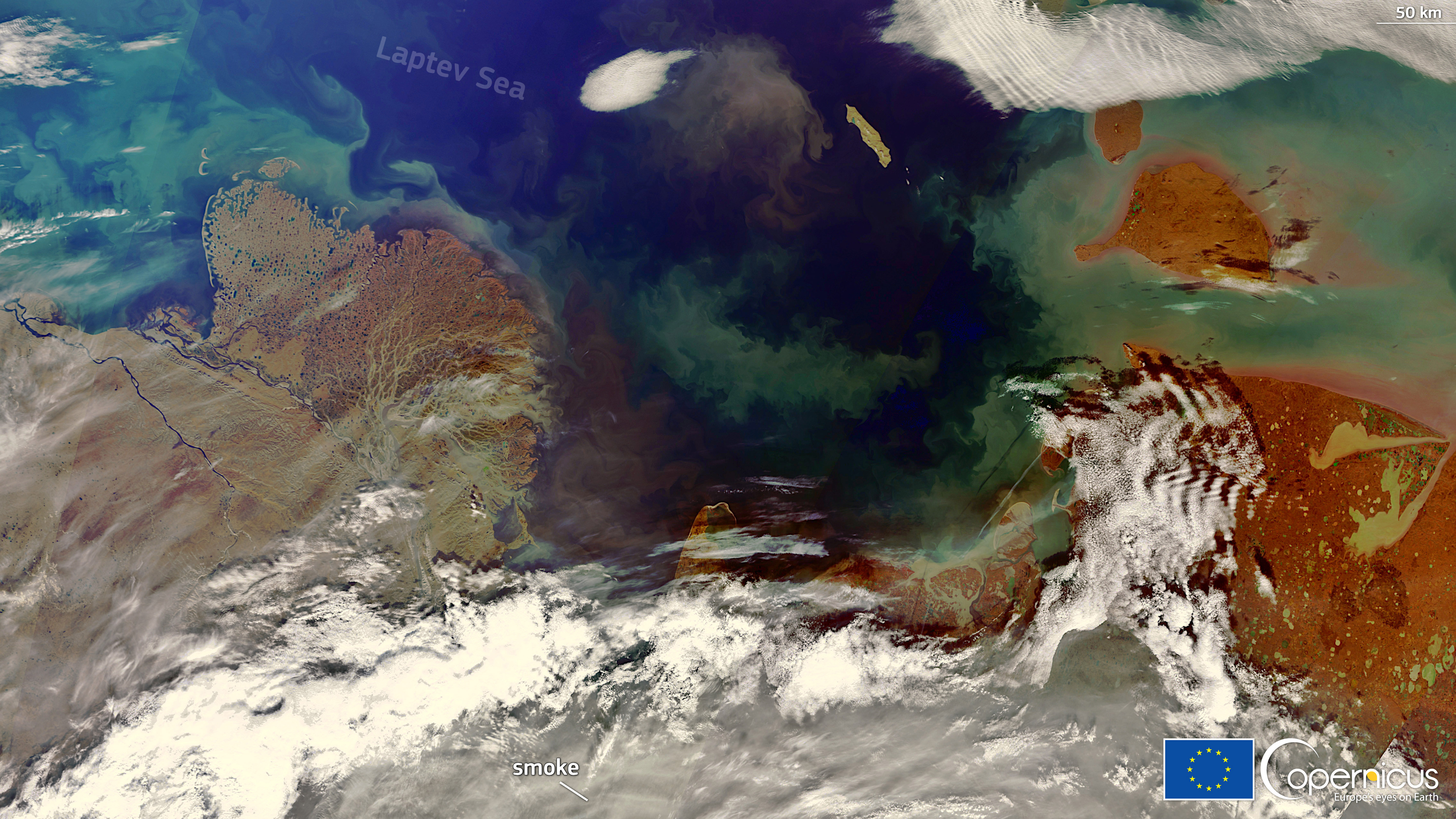
Tuesday, September 14, 2021: The Laptev Sea in the Arctic can be seen completely free of ice in this image captured by the European Copernicus Sentinel-3 satellite on Monday, Sep 13.
The Laptev Sea, in the Russian northeast, is one of the coldest regions of the Arctic Ocean. With temperatures below 0 °С (32 °F) for the majority of the year, the Laptev Sea is one of the major ice-forming areas in the world's oceans. August 2021, however, saw the lowest sea ice coverage in the region since measurements began in 1980, according to the European Organisation for the Exploitation of Meteorological Satellites (EUMETSAT).
According to climate researchers, the Arctic region is on average experiencing faster warming than the rest of the planet, an effect that contributes to the fast melting of ice sheets and the rise of sea levels.
However, in other parts of the Arctic Ocean, scientists have reported a more optimistic situation this year. The U.S. National Snow and Ice Center said earlier this month that the overall Arctic sea ice extent has declined more slowly this summer than in previous years. The center expects that this year's minimum will be among the highest since 2007. In the Antarctic, where sea ice is currently at its maximum, the situation also seems optimistic, with monthly mean extent for August the fifth highest since satellite measurements began. -- Tereza Pultarova
ExoMars orbiter captures tectonic fissures on Mars

Monday, September 13, 2021: Europe's ExoMars Trace Gas Orbiter captured this image of a young volcanic region in the Elysium Planitia on Mars showing two parallel fissures that in the past had given rise to a frozen sea near the planet's equator.
The image, taken on April 14, shows the two 1.2-mile (2 kilometer) wide Cerberus Fossae trenches, crossing the volcanic region at about 10 degrees north. The floor of the nearly 620-mile-long (1,000 km) trenches is covered with coarse-grained sand that appears blue in the false-colored image, captured by the orbiter's CaSSIS camera. Geologists expect the sand inside the fissures, which are several hundred meters deep, to be made of basalt, a common volcanic rock that can also be seen in small impact craters that punctuate the plain.
Elysium Planitia is the second largest volcanic region on Mars. In 2005, another European orbiter, ExoMars, found what appeared to be a 500-mile-wide (800 km) ice sheet covered with ash in this region. Holding about as much water as the North Sea, the ice is believed to have come from underground water that had flooded the region through the two fissures captured in this image several million years ago. -- Tereza Pultarova
Italy at night - from space
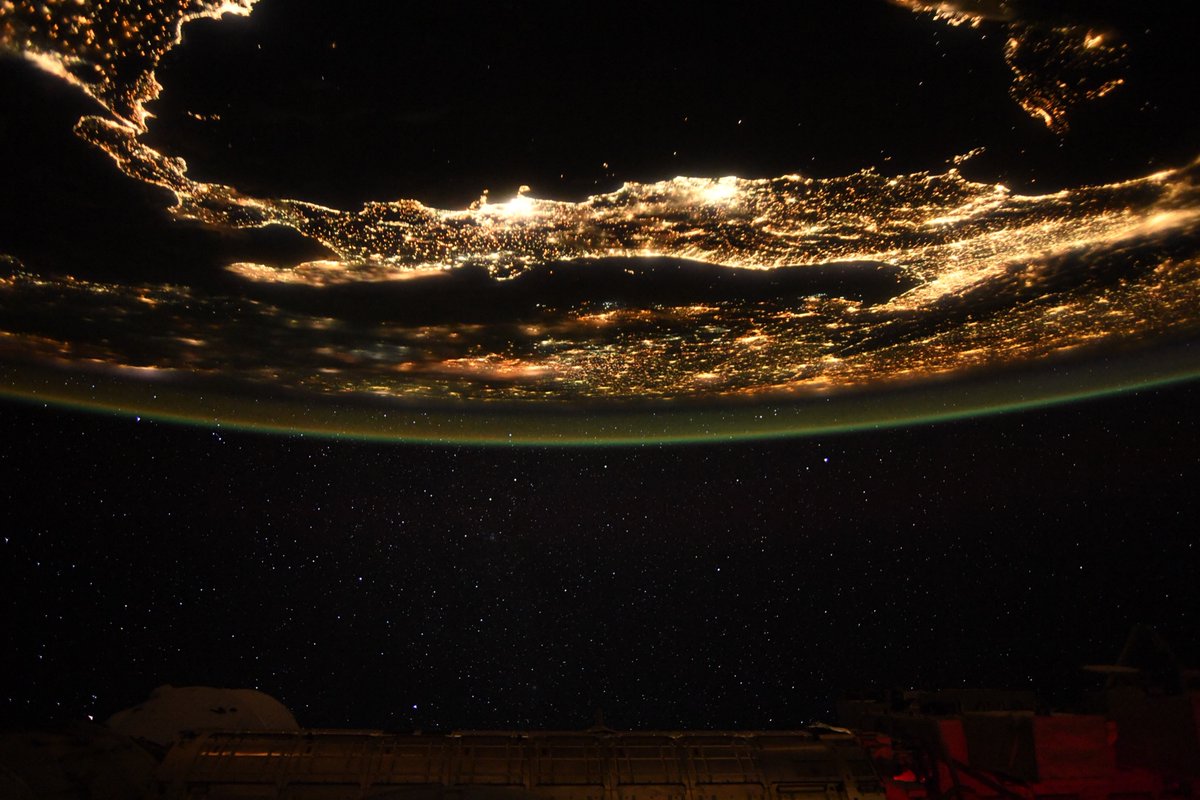
Friday, Sept. 10, 2021: NASA Astronaut, Meghan McArthur has taken this photo of Italy at night from space. The photo was uploaded to her Twitter account and viewers can see the contrast between the darkness of the seas at night and the brightness of Italy and some of mainland Europe, in particular the cities of Rome and Naples.
McArthur took the photo on board the International Space Station and in the same tweet wrote that she is: "starting to learn night photography from our local ISS experts, Thomas Pesquet and Shane Kimbrough." -- Alexander Cox
A sparkly cluster
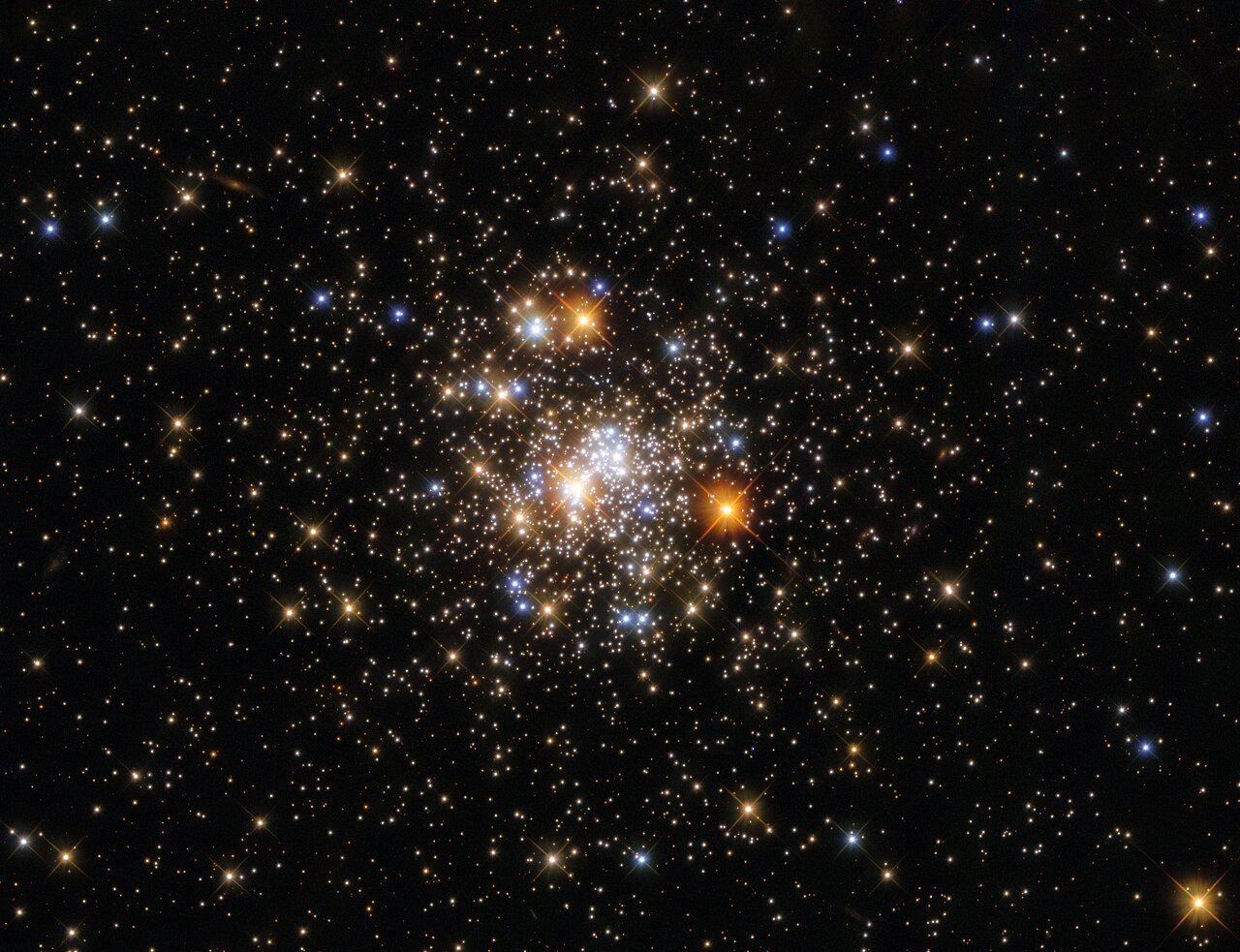
Thursday, Sept. 9, 2021: The dazzling globular cluster NGC 6717 sparkles in the constellation Sagittarius in this view from the Hubble Space Telescope released on Sept. 6. NGC 6717 is located more than 20,000 light-years from Earth an is roughly the shape of a sphere. Such globular clusters are packed in a way that they contain more stars in their centers than along their outer regions, according to the European Space Agency. Some of the extremely bright objects in the cluster are actually stars that are closer to Earth than NGC 6717, and happened to be in the view of Hubble They have clear X-shaped cross-hatching effects caused by interactions of their starlight and structures in Hubble's secondary mirror. -- Tariq Malik
Eclipsed moon shines over South American observatory

Wednesday, Sept. 8, 2021: Although May 2021's total lunar eclipse was visible to few skywatchers, plenty of people were able to admire the partially eclipsed moon. Astrophotographer Yuri Beletsky snagged a particularly stunning image of the eclipsed moon in early twilight as seen over Chile's Paranal Observatory, operated by the European Southern Observatory (ESO). Capturing the image required staking out a location about 5.6 miles (9 kilometers) east of the observatory, according to an ESO statement. -- Meghan Bartels
Virtual reality apps help astronauts service space station

Friday, September 3, 2021: NASA astronauts Megan McArthur is testing a virtual reality headset during experiments at the International Space Station.
The technology will help astronauts perform complex tasks autonomously without guidance from Earth, which will be critical for missions deeper into space, such as a trip to the moon and Mars, NASA said in a statement.
McArthur is wearing Microsoft's HoloLens headset, which has been delivered to the space station in April as part of the T2AR (T2 Augmented Reality) experiment. The headset runs custom-built AR software that helps astronauts inspect and fix pieces of hardware without having to call the ground control or look up instructions on a computer or a tablet.
Japanese astronaut Soichi Noguchi managed to repair a treadmill just with the help of the headset in April this year. -- Tereza Pultarova
Perseverance drills a hole to take a sample
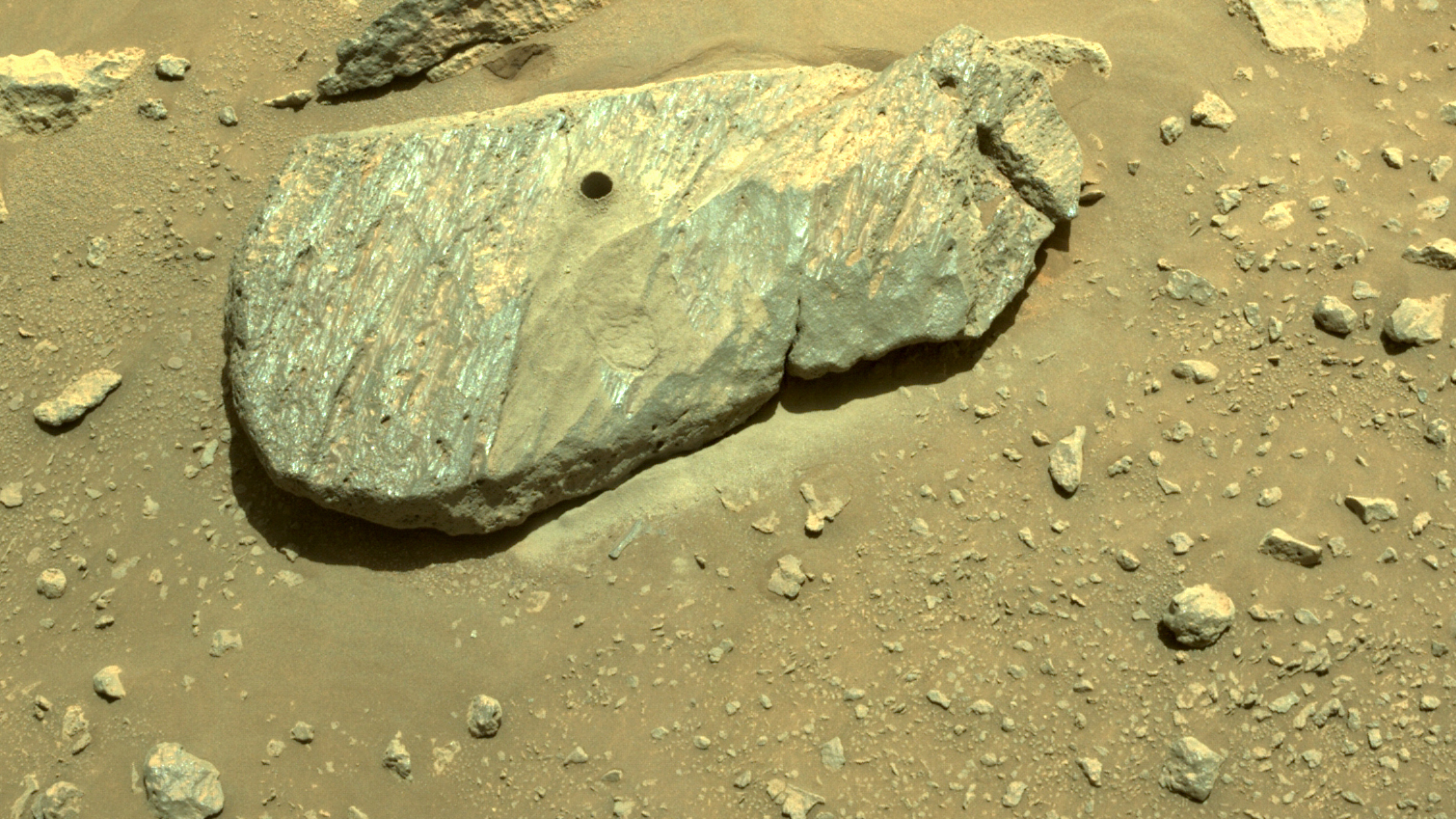
Thursday, September 2, 2021: NASA's Mars rover Perseverance drilled this hole into a piece of rock dubbed Rochette on Wednesday (Sep 1), as it prepares to collect a precious sample to return to Earth in the future.
Scientists selected Rochette for Perserverance's second attempt to collect a sample after a failure on Aug 6. The first targeted rock eventually turned out to be too crumbly and fell apart before making it into the sampling tube.
This new image, showing a neat hole freshly drilled in the rock, was shared by the NASA Mars Perseverance Rover team on Twitter on Thursday (Sep 2).
"#SamplingMars is underway," the team said in the Tweet. "I've drilled into my rock target, and my team will be looking at more data and images to confirm if we were able to get and retain an intact core."
Perseverance landed on the floor of Mars' 28-mile-wide (45 kilometers) Jezero Crater on Feb. 18, tasked with hunting for signs of ancient Mars life and collecting dozens of samples for future return to Earth. -- Tereza Pultarova
Satellites capture Syrian oil spill approaching coast of Cyprus
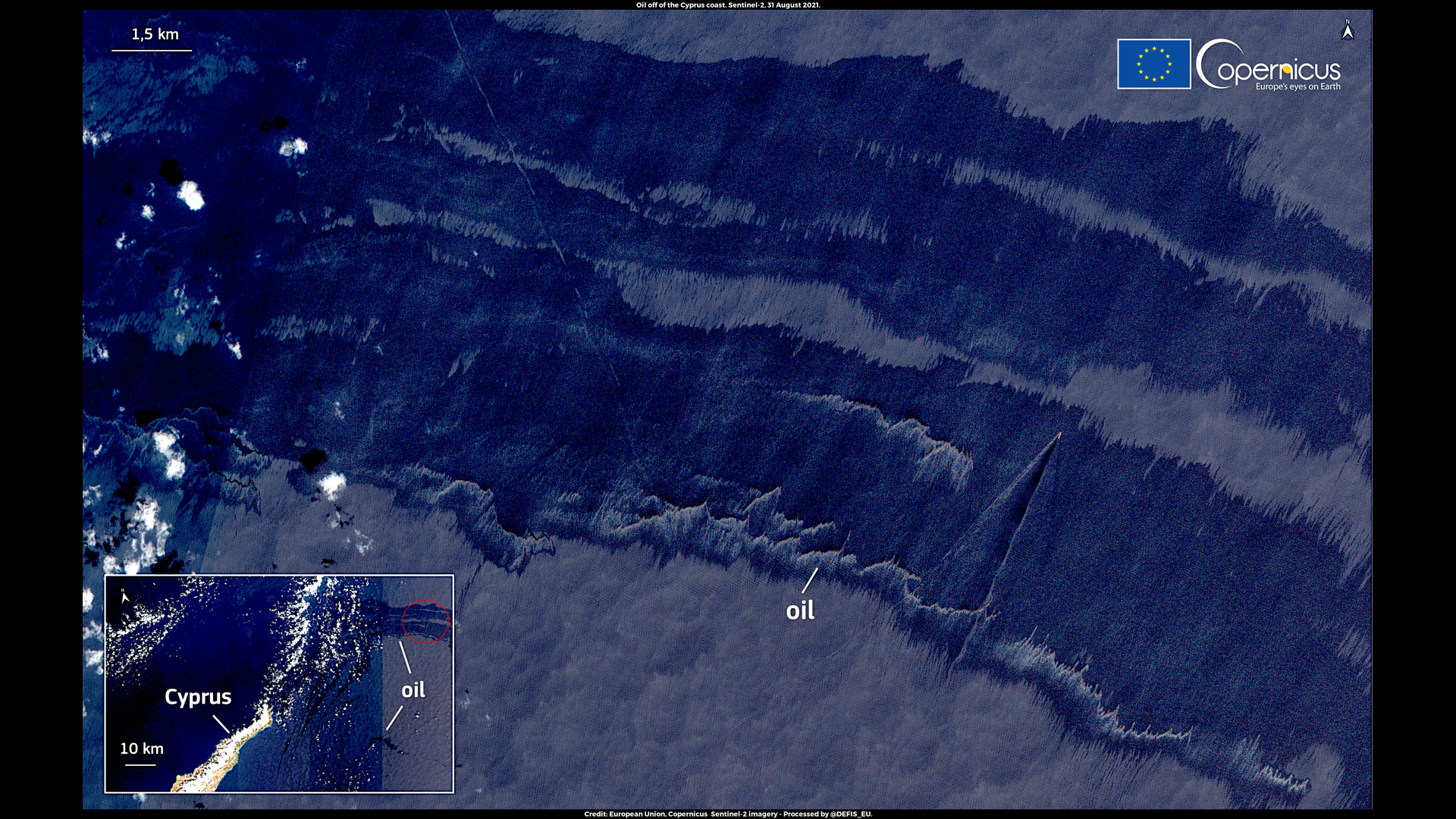
Wednesday, September 1, 2021: A massive oil spill from a large refinery on the coast of Syria has spread into the Mediterranean Sea and is now threatening Cyprus, satellite images reveal.
The European Sentinel 2 satellite, part of the Copernicus Earth observation program, first imaged the spill on August 24. Since then, the oil slick, which originated at the town of Baniyas, has drifted northwards along the coast of Syria before being carried into the open sea and towards Cyprus.
This image, acquired by Sentinel-2 on Tuesday, August 31, shows a large amount of oil drifting less than 18 miles (30 kilometers) off the northern coast of the island.
Citing satellite image analysis company Orbital EOS, CNN reported that the oil slick was covering an area of 309 square miles (800 square kilometers), about the size of New York City. Local authorities on Cyprus reportedly predicted that the spill will reach the northern coast of Cyprus on Wednesday.
About 15,000 tons of fuel are believed to have leaked from the Baniyas refinery since Wednesday, August 23. The spill will likely decimate marine life in the region where many depend on fishing for their livelihood. -- Tereza Pultarova
Join our Space Forums to keep talking space on the latest missions, night sky and more! And if you have a news tip, correction or comment, let us know at: community@space.com.
Current page: Page 1
Next Page Page 2

Space.com is the premier source of space exploration, innovation and astronomy news, chronicling (and celebrating) humanity's ongoing expansion across the final frontier. Originally founded in 1999, Space.com is, and always has been, the passion of writers and editors who are space fans and also trained journalists. Our current news team consists of Editor-in-Chief Tariq Malik; Editor Hanneke Weitering, Senior Space Writer Mike Wall; Senior Writer Meghan Bartels; Senior Writer Chelsea Gohd, Senior Writer Tereza Pultarova and Staff Writer Alexander Cox, focusing on e-commerce. Senior Producer Steve Spaleta oversees our space videos, with Diana Whitcroft as our Social Media Editor.
Drawings That Can Be Seen From Space
Source: https://www.space.com/34-image-day.html
0 Response to "Drawings That Can Be Seen From Space"
Post a Comment